#love a Robin Hood/Catwoman type love interest
Explore tagged Tumblr posts
Text

I just know she’d be best friends with Mal Volari <3
#either that or they’d be in total competition with one another lmao#love a Robin Hood/Catwoman type love interest#playchoices#blades of light and shadow#the deadliest game#farah sabri#mal Volari
40 notes
·
View notes
Text
dc super hero girls ( 2019 ) swap au because I have no self control. it’s essentially just a role swap of the villain group and the hero’s ( and batman with the joker, mostly for narrative )
the hero ( formerly villain ) group themselves are INCREDIBLY unorthodox, mostly because none of them other than harleen and selina ever wanted to do something for other people before, they were mostly using their powers for selfish reasons ( not evil ones, just for personal gain ) so even though they’re all learning to be better people they’re not super well liked by the general public because of their destructive and frankly dangerous methods ( mostly adults hate them, other teenagers think they’re the coolest ) they’re referred to as vigilantes more rather than actual heroes
harleen swaps with babs, she still retains her canon personality she’s less apathetic, and genuinely cares deeply for a lot of her friends. she still loves playing pranks and practical jokes, but she’s less rowdy and rambunctious in the beginning, especially when she meets new people, mostly because she’s now really worried about making a good impression and not getting into too much trouble. rather than her dad taking a new job in metropolis, harleen got expelled from gotham high for playing a big prank ( it’s a running gag that no one but babs knows what it was ) and her dad was so pissed that she got kicked out of the only high school in gotham that he kicked her out. she lied about her address to her address to get into metropolis high, and she’s really trying her best to do well in school, and like diana was in canon, she was kinda just homeless for a bit. since the joker is a superhero in this universe, harley quinn ( a superhero name the others poke fun at sometimes because of how obvious it is ) is a crime fighting vigilante
selina swaps with diana, she isn’t an amazonian or anything ( that’s still diana ) but instead she’s more of a robin hood type character pre canon. she’d steal from banks or take valuables and sell them on the black market and give the money to people and families who need it, which isn’t an amazing tactic, but her intentions were good. she didn’t have any real interest or intention in starting a superhero group or actually fighting any crime before harleen brings up the idea, but she has been keeping a close eye on a couple girls ( pam, leslie, doris, carol ) at school that she thinks might have superpowers. once the group is formed she is the leader, mostly because she has the most battle iq / experience. like diana, she is the one leading the main training in the beginning, and though she’s the elected ‘leader’ she’s not really the mom of the group. she does care deeply about her team though, and she does try her best to keep them safe. she’s the least destructive member of the team because of how practiced she is at sneaking in and out of places without getting caught but she’s one of the most disliked because of catwoman’s already existing presence pre show, her intentions were good, but robbing banks is bad
the rest of the girls are less obvious swaps, it’s mostly just the villains are now heroes and the heroes are now villains
leslie is the more tech savvy one ( like karen ) she’s actually super smart which comes as shock to people based on her punk looks ( she hates when people say she doesn’t look like she’d enjoy math or science ) she’s not a bully anymore, instead, like kara she’s more sarcastic and just pokes fun at people, though it she takes it too far with people she cares about she’s very quick to apologize. she’s the one who is put under ra’s’ spell ( she’s still super punk guys OF COURSE she loved the league of shadows ) and her lighting gets all red and stuff and she looks super cool. she’s actually part of school newspaper, since she’s nicer, she doesn’t run a gossip column ( though she’s constantly BEGGING lois to let her start one ) she’s instead a field reporter, who always manages her to somehow get the inside scoop and really good pictures ( she’s hiding out the in tech guys ) also her and doris are one hundred percent going out
doris is more the mom of the group, she’s no longer a bully and instead uses her strength to defend people she cares about / beat the shit out of people she doesn’t like, she gets in trouble a lot because she’s constantly beating up kids at school who make fun of pam. her and pam are really close because their parents are both scientists and they grew up hanging out at labs together. both of them were experimented on by their parents, and have been aware of eachothers powers for a while. she’s super over protective of the others in the group, mostly pam ( because they’re basically sisters ) leslie ( cause they’re going out ) and harleen ( because harleen’s always putting herself into harms way ) she’s quite literally the type to just grab her friends and walk away with them tucked under her arms if she feels that something isn’t safe, despite their protesting. she’s the world’s biggest man hater ever, she gets pissed off so much if a guy says something misogynistic to her or her friends, her powers act ho so much it’s not even funny
carol is still the overemotional one of the group, though it’s mostly because her ring is more connected to strong emotions rather than love, but because she still not super sure how to control her ring yet ( none of the others really know what to do either so they’re all just trying their best ) so whenever her friends, or anyone else around her frankly, are feeling something really strong it effects her pretty deeply. she’s not obsessed with hal, though they are still exes, but him being a shitty boyfriend is one of the reasons she became so intune with her ring in the first place. she’s like the opposite of a therapist friend, in the sense of she’s a friend constantly trying to give therapy but also needs it more than anything. her and thaal are the definition of ‘twink and in denial lesbian’ friendship ( and she totally doesn’t dump to him about how hot she thinks lois lane is, even if she is trying to uncover the identities, they’re essentially this aus barry and babs ) she’s still a hopeless romantic, and is constantly gushing to the others about her ‘dream’ guy ( and theyr all like ‘carol you dumb lesbian my god!’ )
pam is basically the same, other than the fact that she’s less inclined to use her powers, mostly because she’s scared to. she really only goes into poison ivy form when she desperately needs to photosynthesize and when she’s either completely alone or with doris. her parents exterminated on her when she was little, and because of that fact that they literally turned her into a walking plant she’s completely incapable of eating plants ( people just think she has a weird medical condition ) though she’s still anti social, she does quite enjoy the company of a select few people. when she does finally agree to join the others in becoming a super hero, she really only does it / participates in certain crimes to try and help the environment. it isn’t until she and harley come face to face with batgirl that she finally starts using her powers to actually fight. she’s also less anti social, she still doesn’t have many friends, but it’s mostly because she’s shy and not because she doesn’t want them ( her and karen have basically swapped personalities ) she’s very much the sweetest member of the group ( leslie, doris and her are literally simon, alvin and theodore )
diana is a lot more like her aunt antiope, she spent a lot more time with her as a child and so she’s a lot more reckless and carefree. she doesn’t really care that much about her teammates, and to her they’re really just pawns she uses to achieve her goals and help her have a good time. she’s still new to metropolis, having just arrived at the time of the first episode, but rather than wanting to protect the world of man, she instead just wants to cause problems, have fun and possibly grow rich. antiope sent her the the human world willingly, because in this universe she’s the older sister and is the queen of the amazonians, rather than diana’s mom. she’s less academic and way more sporty, a trait she’s picked up from her aunt since she never really had to study when she was younger. diana is incredibly manipulative in this au, almost every member of her group was manipulated into joining by her, and it continues as long as they remain part of the group
( bonus : the episode #thewarriorandthejester plays out basically the same, including diana figuring out harleen is harley quinn. during nightmare in gotham diana is present, and when harley’s tied up on the roof she reveals to babs that harleen is harley )
babs’ dad is still commissioner gordon, but she instead idolizes batman, and since batman’s a bad guy in this universe, so is babs ( she’s just extra careful about keeping her identity a secret ) like in canon, babs is extremely hyperactive, but in this universe it’s a lot more unchecked. since harleen forced herself to learn how to tone down and not always draw attention to herself in fear of getting kicked out again, her babs’ energy doesn’t match eachother’s as well as it used to. babs lacks a filter, so she’ll often just say what she doesn’t like about someone to their face, which is one of the reasons harleen’s new friends don’t like her as much. batgirl is a lot meaner in this universe, she’s rude, and blatantly makes fun of people, particularly harley ( cough … the reason pam gets so worked up and uses her powers in a fighting sense … cough ) while out of the costume harleen still is the more overprotective one ( she still would willingly kill for babs ) babs is the one who often goes to extreme measures to make sure the other is happy
zee is somewhat of an accidental villain, she used dark magic one time on accident ( she caused the gremlins to spew out of ace of spades a lot earlier on ) and diana, who witnessed this, pressured her into jointing her villain group, claiming it would help her ‘learn to control her dark magic better’ ( spoiler alert, it doesn’t ) while zee enjoys the freedom and publicity being a villain brings her, she really doesn’t enjoy using her dark magic, because she has no idea how to control it, she avoids using it most of time, because when she does use it, things get chaotic and very out of hand. she’s still the most popular girl in school out of costume, but she’s a lot less nice ( she’s stereotypical mean girl core and I’m sorry ) she’s a lot less open and kind as she is in canon, even to her friends, she’s a total asshole to everyone but especially to her friends
karen is a little wet rat in this universe, she was tired of being called small and weak and being picked on, so she built the bumblebee suit with the intention of getting revenge, but even with the broken growth tech diana still recruited her to her team, karen being the only one she didn’t have to manipulate in some way. she used to be incredibly shy, and while she’s still anti social ( her and pam have kind of swapped personalities ) she’s just rude now, and thats why she doesn’t have many friends. she’s a little wet rat and will a hundred percent bite you. she’s still constantly fix her growth tech, but she also refuses to let any of her team mates help her. basically all of them besides diana and maybe jessica like hate her because she’s so rude to them all of time and never follows any of their plans and just does her own thing half the time, but diana won’t listen to them when the tell her to kick karen off the team
jessica doesn’t want to be a villain, she definitely doesn’t enjoy it, like zee and literally every but karen, she was manipulated by diana to joining the team. like pam in canon, most of her motives for doing literally anything villain related is when she sees or hears about social injustices that she wants to fix. she does believe in fighting in this universe, she doesn’t love it, but she thinks that the only way to deal with social injustices is to use violence to punish people. in this universe, her fears of not being good enough for the green lantern core got the best of her and she ran off, quitting and instead taking up a yellow ring ( thaal still has his green ring in this au ) she’s a lot less of a social butterfly, she still uses school as a place to voice abut problems around metropolis, but because she’s a lot more self conscious the negative response get to her a lot more. she’s no longer like “I don’t know the meaning of the words leave it alone” and more just “oh … okay I’ll stop 😞” she’s still one who tries befriend pam, and they’re still adorable and probably dating. she also needs a hug asap
kara became a villain because she was really jealous of super man ( he’s still a hero in this universe ) and diana used that against her. she started out trying to be a hero but literally no one cared and they all called her destructive so diana was like “become a villain and then you can beat up your cousin mwa ha ha” and she was like “that sounds dope I’m in” when zod shows up, she still helps defeat him, because she still wants to be a hero deep down, she wants to help people, but diana won’t let any of them leave her villain group. she does try to help people whenever she thinks diana isn’t looking, and she always tries desperately not to hurt people when they’re pulling off heights or schemes. she’s still destructive and thinks punching things is a solution to everything mostly because diana tells her that it’s a great idea to do that, and so she’s never really learned any other way to deal with problems
lena and lex swap, so he’s the little rat child and she’s the super genius billionaire asshole. people don’t love lena as much as they do lex in canon mostly because she’s still a bit of a brat. she’s still beloved and held to a super high regard but people are also like “she’s also super fucking weird and is like a rat” she also has a keytar because fuck it ricky owens reference. so when she’s fighting with the girls instead of some weird dance she’s like putting on a little concert for them. most of her robots that need to be manually controlled have a piano as the control piano, so when lex is fighting the girls in the beginning he’s just slamming his hands on random keys and hoping it works
barbi still starts out a villain, she’s jealous that harleen became captain of the gymnastics team and was like “magic is the only solution fuck it” her and selina are exes but it’s so obvious they have not gotten over eachother at all ( “why’d she break up with you selina?” “it was over something stupid - I stole from her” “that’s a really good reason to dump you” ) cheetah is still a villain until around after the girls fight when lena because she was captured and then like immediately let her out and selina like was begging her to be a good guy with them, she late becomes an honorary member of the team. while she was captured she was in the tube next to selina and the whole time selina was like “barbi I’m sorry please take me back 😭”
the joker and batman swap so babs is the one who idolizes a villain and harleen idolizes a hero. the hive five also swap with the teen titans
dexter is literally the same except selina is the one who works at the animal shelter and is the one who adopts him
#chat this was so freaking long yet it’s the summed up version#this took years off my life to write#“this isn’t Scott Pilgrim-“ WELL MAYBE I LOVE DC SUPER HERO GIRLS MORE#also babsleen is canon in this au#dc superhero girls 2019#dcsuperherogirls#dcshg#dcshg 2019#swap au#dcshg swap au#harley quinn#harleen quinzel#batgirl#barbara gordon#cat woman#selina kyle#poison ivy#pamela isley#livewire#green lantern#supergirl#wonder woman#bumblebee#the joker#dc comics#dc superheroes
47 notes
·
View notes
Photo
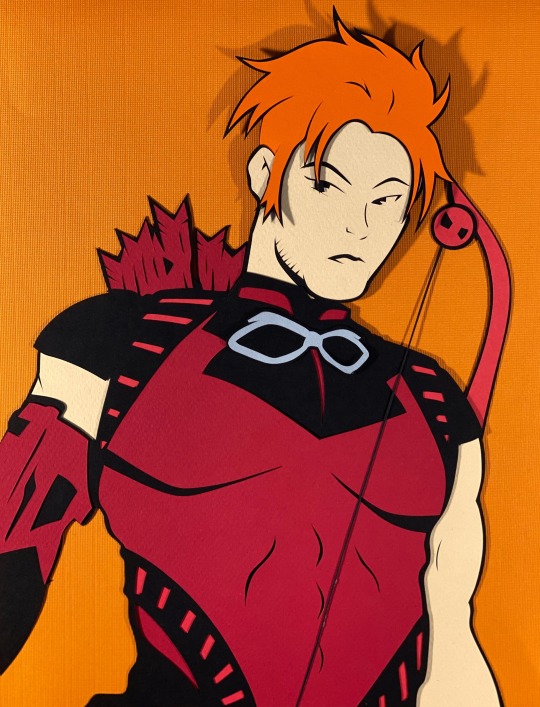
365 DC Comics Paper Cut-Out SuperHeroes - One Hero, Every Day, All Year…
September 29th - Arsenal
Roy Harper was just an infant when his park ranger father was killed in a terrible forest fire. Roy would have perished as well, but he was saved by a man named Brave Bow. With no one available to care for the child, Brave Bow took Roy back to his tribe where Roy was raised in the traditions of the Navajo people. Roy particularly excelled at archery and went on to win numerous contests.
In his early adolescence, Roy learned about the super hero Green Arrow and he came to idolized him greatly. Not long thereafter, Brave Bow was diagnosed with a terminal illness and he reached out to Green Arrow asking the hero to take guardianship of young Roy after his passing. Oliver Queen (Green Arrow’s civilian identity) took interest in the matter and ultimately agreed to take on Roy as his ward.
It wasn’t long before Roy discovered his new guardian’s secret and the lad was able to convince the hero to allow him to act as his sidekick. Roy earned the nickname ‘Speedy’ after his quick draw enabled him to ensnare a couple of criminals before Green Arrow had the chance to. This nickname would go on to become Roy’s official super hero alias.
Following many adventures alongside Green Arrow, Speedy would help establish the first iteration of The Teen Titans, banding together with other sidekicks, including Robin, Wonder Girl, Kid Flash and Aqualad. It was a terrific time in Roy’s life. The Titans would have many exciting adventures and Roy had a romance with his fellow Titan Wonder Girl. Sadly, the good times did not last. The Titans ultimately broke up and Green Arrow left Star City to go on adventures abroad, leaving Roy on his own. In his loneliness, Roy turned to drugs and he ended up forming a crippling addiction to heroin.
Black Canary helped Roy kick the habit and beat his addiction. Following this harrowing experience, Roy went to work with the US Drug Enforcement Administration (DEA), acting as a counselor in various anti-drug programs as well as helping to take down drug operations and cartels. His work with the DEA led to Roy’s joining the Central Bureau of Intelligence (CBI). While on an undercover assignment with this organization in Japan, Roy was assigned to capture the assassin Cheshire, yet the two ended up falling in love with each other.
Roy allowed Cheshire to escape, not realizing that their brief affair would ultimately produce a daughter whom Cheshire named Lian. Roy learned of his daughter’s existence a bout a year later. Teaming up with Nightwing, Roy was able to finally track Cheshire down so that he could see Lian. Cheshire ultimately decided that Lian would likely be safer with her father and allowed Roy full custody of the their daughter.
Roy raised Liam as best he could. In order to provide for her, Roy accepted work from the spy agency known as Checkmate. At this point, Roy came to retire his alias of Speedy and took to calling himself ‘Arsenal,’ emphasizing the fact that he had become extraordinarily proficient with numerous types of weapons alongside the bow and arrow. As Arsenal, Roy would have numerous adventures. He returned to a reformed version of The Titans and later helped to form a new iteration of The Outsiders. Some time thereafter, Roy took on the name ‘Red Arrow’ when he was recruited to join The Justice League of America.
Red Arrow proved a valued member of the League. Then disaster struck. The villain known as Prometheus caused an earthquake that devastated Star City and young Lian perished in the cataclysm. Unhinged over the loss of his daughter, Roy became callus and bloodthirsty. Roy joined Deathstroke’s new, deadly version of the Titans. He ultimately discovered that Deathstroke was drugging him to make him compliant to his wishes. Roy ultimately defeated Deathstroke and vowed to reform a new and heroic version of the Titans to honor his daughter’s legacy.
During The Convergence event, Roy was offered a devil’s bargain from the powerful entity known as The Dreamslayer. This villain offered to resurrect Roy’s daughter in exchange for his betraying his friends. Roy is able to outsmart The Dreamslayer and his Lian is resurrected without the betrayal.
Aspects of Roy’s backstory were altered following the Nu52 reboot. Here Roy has resumed the mantle of Arsenal and is a member of The Red Hood’s covert team called The Outlaws. Liam’s fate had been left a mystery for a while, but it was ultimately revealed that she is now the adolescent associate of Catwoman known as Cheshire Cat who, suffering from a type of amnesia, does not know who her parents are.
Arsenal was believed to have perished during the Death Metal event. He actually survived but decided to keep the matter a secret needed a break from his life as a super hero. Roy’s retirement proved short lived as he was pulled into action, now wielding a black power ring; and soon there after he was recruited into the ranks of The Justice League Incarnate.
Actor Colton Haynes portrayed a version of Roy Harper in the television series Arrow. The hero first appeared in the pages of More Fun Comics #73 (1941).
#365 DC Comics Heroes#DC Comics#Arsenal#Green Arrow#Teen Titans#Outsiders#Justice League#Outlaws#Speedy#Red Arrow#Arrow#Colton Haynes#cut-out#paper art
136 notes
·
View notes
Text
Badger Snakes and The "Red-Stained Ledger"
Since my recent announcement identifying as a Badger Snake (don't @ me if I change my primary at some point lol still going back over that one,) I've looked up some characters that have been identified as Badger Snakes, and found two things:
1) There weren't very many in fiction and
2) most go through the same personal journey I had described in my previous post.
By that, I mean, a very similar feeling of self-loathing or feeling as though you have some dirty secret to hide, AKA the Red-Stained Ledger Natasha Romanoff refers to. The two main ones that have been agreed upon I'll be focusing on are Woody from Toy Story and the aforementioned Black Widow, but I'll also be bringing two new characters into the fray, one that's been sorted as such based on the portrayal, and one that I've discovered on my own. They are Selina Kyle AKA Catwoman and Dewey Finn from School of Rock.
It's interesting to find the similar plotlines that certain sortings are given consistently in media, and The Power Behind the Throne AKA Badger Snake seems to pretty much only have the one: They fight for the group that they are loyal to, but they can't seem to help but do so in a way that they aren't proud of, one that they're sure would lead said group to shun them.
I'm sure someone could point out a character I'm not referencing here that doesn't have that plot, but at the very least, this plot dominates the sorting.
Woody in the first movie goes through exactly that issue. He only wants to fight for Andy's toys, and in many ways, all toys he comes across. He makes choices that he believes will benefit everyone, and prides himself on being able to make the "tough choices." But, he ends up having to do so in a "duplicitous" way, when he seeks to manipulate Buzz Lightyear out of his group. This is a horrible, dirty secret to him, and he feels almost as if he could never return to them, never show his face again because of how he chooses to fight. In the end, he reaffirms that his actions come from a good place, a place of love for his group, and finds ways to use his crafty talents that are slightly more constructive and a little less "cloak and dagger."
Natasha Romanoff has given me the namesake for this Badger Snake element: the Red-Stained Ledger. She describes her desire to fight for her country, for her family, but struggles with what she knows she's good at. She believes she's inherently a bad person and is determined to remain a loner due to her "badness," due to the "monster" she is. Good people don't lie or manipulate. Good people... uh... I dunno, bake cakes or something? Work humble jobs? But, her contribution to the world, her ability to be clever and tricky, means that holding her group, her country, her family, the Avengers themselves, only in her heart and not in her hands. But, her true colors are shown in her never-ending dedication to the cause, down to her being willing to give her life so that no one else has to do it. In a way, it's sad, because she died believing she in some way deserved it. But, none of her teammates felt that way about her. She may have been crafty, a master manipulator, and a skillful liar, but she was the farthest thing from bad.
Now, onto the two newer additions. I've seen Selina Kyle sorted as Double Snake, and I would agree that there are many interpretations that could fit the bill. But, if you ask me, the truest interpretation of her is as The Power Behind the Throne, the Robin Hood with no loud cause to shout from the rooftops; only a desire to help the people of Gotham. She uses her skills as a thief to act as a sort of "guardian angel" to the poorest in Gotham, but she has no grand statement to make. She sees people hurting, her group, the underdogs of Gotham, and came to their aid. But she does so quietly, secretly, because she believes in her heart that the way she has done so is not worthy of praise. She's a con and a thief, but, she places people above all else. She, in some interpretations, is one of the main people to open Bruce's eyes to the fact that not all criminals are necessarily bad people. Some of them are just in terrible situations they can't get out of. And yet, she won't afford that benefit of the doubt to herself, believing she is simply a broken toy not worth fixing. Her occasionally lackadaisical attitude towards killing may seem to make Badger primary unlikely, but Badgers are not always loyal to ALL humans. Her group is the poor and downtrodden, and those who act against them are less than human in her eyes.
Now, we come to my personal favorite, my own personal discovery: Dewey Finn from one of my favorite movies, School of Rock.
Dewey is a fabulous example of a Badger Snake, in my personal opinion. His chosen group is Rock with a Capital R and "the band," whichever band that may currently be. He may have some sort of Burnt Snake primary performance/model going on, wanting to play the part of a "rock star" that truly only cares about himself, but his true loyalty is very clear. He is worried about doing his chosen group justice in every way, making sure that Rock is being well-represented and that he's serving his current band the very best he has to offer. Being kicked out of his band at the very beginning is earth-shattering to him, not because he has a Snake primary style devotion to only them, but because they told him he let them down, and implying that he wasn't representing Rock the way he should. His Snake primary performance/model melts away as he bonds to his new band, the kids he teaches. He brings them into his chosen group of Rock and creates a new bonded group with them in particular as they form a band. He actually finds himself liberated by taking a backseat to the children (a very Badger primary thing to enjoy,) allowing Zack to play his song, guiding Freddie away from making bad choices, helping Tamika find her voice, encouraging fellow Snake secondary Summer how to use her shrewdness, and, using a method I believe is best utilized by Badger Snakes, helping Principal Mullins find her chill. Lol.
Badger Snakes, more than any other Snake secondary type, will rely on the "we aren't so different you and I" approach to get what they want. He finds out Mullins also enjoys Rock. This is something they have in common! Let's create a situation where we "naturally" find out we have this thing in common, placing us both in the same group. Although other primaries don't glorify groups as much as Badger primaries do, all people are more likely to listen to or help out someone they feel is like them in some way. So, Dewey puts some Stevie Nicks on the jukebox and gets Mullins on his side.
In a similar fashion to the characters listed above, Dewey believes he is truly a loser and has nothing of any actual value or goodness to provide. But, the children help him see he's wrong, and he finds a way to utilize his talents in a way that truly fulfills him.
In conclusion, although seemingly unrepresented, I think there actually may be quite a few more Badger Snakes hiding in media, and, perhaps, they can be outed by looking for the Red-Stained Ledger plotline. Badger primaries are more likely, in my opinion, to be disturbed by their actions than say a Lion primary, due to where their loyalties truly lie. Although Lions may fight for the right thing, and that right thing may involve people's rights or serving a group, they serve that right thing before any of the people they may steamroll over to achieve it. Badgers, by definition, serve things. And, usually, lying, cheating, or otherwise being crafty is viewed as the worst possible way to serve someone or something. They do care about the things they may hurt or damage through their actions, and how they use their talents does, in fact, matter to them immensely.
So, to my Badger Snakes out there struggling with their own so-called "Red-Stained Ledgers", just remember that Dewey Finn would think you're kick-ass.
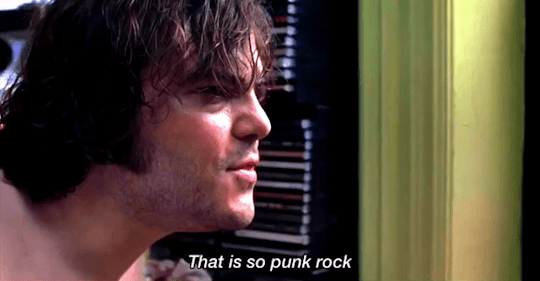
EDIT: Sorry, was thinking about it, and had to put an edit. Another way to think of this plotline/character archetype is mentioned in School of Rock as well as in a musical I know very well. I wouldn't use this moniker as the name for this plotline, only because it describes a very specific Snake secondary, one that is playful and light-hearted, and not all Snake secondaries are like this.
Zack's song refers to Dewey as The Magic Man, a person that swoops in and, almost by magic (in actuality, manipulation) brings out the best in the people around them. In the aforementioned musical, this character is called The Music Man.
Harold Hill may very well be another Badger Snake, although one more heavily disguised than Dewey Finn. I won't go too deep into his characterization here, but know he's a conman who claims to be a band instructor, while he has no musical talent himself, planning on taking the money for the uniforms and instruments and running. Instead, almost without realizing it, he encourages and manipulates the people of the town he enters into becoming better versions of what they are now. And, the most tragic part of his character is revealed once another character, one of the children he's conned, points out that there isn't a band, and never has been one. Harold tells him "I always think there's a band, kid."
It's interesting that, in both of these cases, they are associated with music and an almost mystical ability to bring out the best in others. I might do a more in-depth look at Harold Hill at some point, since I've been planning on doing some musical characters for a bit.
If thinking about having a Red-Stained Ledger is too negative for your own self-image, think of yourself as The Music Man. Your friends and the people around you may actually see you as an almost mystical force for good, someone who always seems to know the right thing to say or do to bring out the best in them. :)
#badger snake#badger primary#snake secondary#sorting hat chats#sortinghatchats#harry potter#hogwarts housing#hufflepuff#slytherin#hogwarts#red-stained ledger#woody toy story#natasha romanoff#black widow#selina kyle#catwoman#dewey finn#school of rock
97 notes
·
View notes
Text
Will Trade Soup for Intel
Potential Gotham Knights ‘verse. For those who did not see the trailer: Bruce is dead (pfft, suuuuure he is), Jim Gordon is dead (Jim, no!), the Court of Owls appears (this is gonna be bad), Batgirl and Robins 1-3 have guardianship of Gotham. For this piece: Penguin is also dead. Dove has his operation. And the flu. :p
***
Tim’s not sure where he thought Jason was going to take him. Honestly, because it’s Jason, he was sort of thinking, ‘seedy hole in the wall where retired hitmen go’. Or something. Or maybe an orphanage, or an under-the-bridge camp; the Alley Kids don’t throw bottles and needles at him, unlike the others. They demand rides.
(Yeah, it’s funny but also scary to see the Red Hood, known for his duffle bag of heads, giving a little girl a piggyback ride.)
This is not one of those places. This is some apartment building in midtown with a doorman and everything. And, y’know, it’s daytime, which...they don’t operate in the daytime that much unless they’re undercover, and they don’t appear to be. Jason told Tim to dress like a real boy and stick his domino on in the elevator, but he’s wearing what he always does; jeans, hoodie, heavy boots. And he’s carrying a brown bag that smells like soup. No helmet in sight, and Tim knows he won’t wear a domino now. They bug the scar*, he says.
“Where are we?”
“To see an old friend. I’m out of other ideas.”
“What, are they a conspiracy professor or something?”
“No.”
The doorman waves them through and they wait for an empty elevator. Jason presses the third-floor button and settles in, adjusting the bag in his arms. For all the crap they give...gave...Bruce about theatrics, Jason’s no better. He lives for building the suspense. Tim had nearly murdered him again for that stupid monk joke. Asshole. Ten minutes from his life, and for that? Humph.
A cotton face mask whaps him in the chest while he’s adjusting his domino and he frowns.
“What.”
“You’re fragile, and she’s got the flu, which is why we’re here in the daytime. I’m basically immune after my, um, upgrade points got cashed in, but you are a Victorian maiden who'll probably turn it into tuberculosis and die and I can’t deal with Dick after that.”
Huh.
…
Whatever. You lose one spleen…
He puts the mask on, too, making sure Jason sees his glower, just as the elevator dings to a halt.
Tim starts to suspect they’re not invited, exactly, when Jason shoves the bag at him and drops down to pick the lock. Though he does knock and call, “Don’t get up!”, so.
“There. Give me that before you spill something...hey, Miss Marquis! I brought soup!”
…
Jason couldn’t have just told him this, why?
There’s furious coughing in the other room, followed by movement, and a minute later Dove shuffles out, wrapped in a blanket and wearing what appear to be bunny slippers. She looks terrible.
“For the tenth time, I don’t care how immune you think you are, you’re going to get sick and I can take care of myself.”
“Haven’t gotten sick yet,” Jason says cheerfully. “‘Sides, it’s, like, partly a bribe.”
Dove doesn’t look convinced. Tim’s not convinced, either. Jason, when left to his own devices, can and will out-mother-hen Dick. He’s just usually scarier when he does it. More like Alfred.
Before any further argument can happen, Dove starts coughing again and winds up clutching the doorframe with one hand and holding the other up to keep Jason at bay.
“Thought you were gonna take Theraflu,” Jason says sulkily. Dove reaches up to pinch the bridge of her nose.
“I will take it if I need it, Hood.” Tim sympathizes. Theraflu tastes like sadness. At least Robitussin is nice. “I promise this isn’t my first flu, I am fine. ” This is not a battle she’ll win. Tim knows. Tim has tried and failed. Jason had loomed at him and told him, oh-so-nicely, that he would take the Theraflu or that it would breach his defenses. “What do you want.”
Jason holds up the bag.
“Fridge or bowl?”
“Fridge, please.”
“Tea?”
“If I say yes, will you settle down?”
“For now.”
She sighs and totters over to an armchair.
“Fine.”
“What kind.”
“I’ve got some sort of zinger tea in there, that would be very nice.”
Jason vanishes into the kitchen. Dove sinks into her chair, pulling her blanket tighter around her shoulders, and waves at the couch.
“Siddown, Robin.”
“Sorry we broke in,” he says, because Jason won’t. Dove just shakes her head.
“This isn’t the first time or the last time,” she says. “At least you used the door...if you need a drink or somethin’, help yourself.”
Jason comes back, steaming mug in his hands.
“I’ll get it,” he says. “Bird boy here shouldn’t touch the kitchen.”
Slander.
“Nightwing’s worse.”
“Still. Here y’go.”
“Thanks, honey.” Dove leans up to take it before shooing him back. “Now. Why are you here.”
Jason settles onto the couch next to Tim and leans forward, worrying at his lower lip.
“This is going to sound crazy.”
“Well, that’s interesting.”
“Do you know anything about the Court of Owls?”
Dove snorts, coughs, and takes a sip of her tea.
“What?”
“You know…beware the court of owls that watches all the time, ruling Gotham from a shadowed perch behind granite and lime. They watch you at your hearth, they watch you in your bed. Speak not a whispered word of them--”
“Or they’ll send the Talon for your head, I know the rhyme.” She takes another sip. “It’s a scary story to keep kids in line, you know that.”
“We thought so, but.” He shrugs. “”Had a run-in with...something...last night that, um. Looked a little dead. But not dead like me, dead like...I don’t know. It was like it wasn’t human anymore. Or ever. I don’t know.”
Well, that’s a surprise. Tim wonders if Jason just straight-up admitted what happened or if Dove got it out of him or from some other source.
“Croc’s not human, either, kid.”
“No. This thing...I didn’t...I broke its neck and it fucking twisted it back into place.”
Dove frowns.
“You’re sure?”
“Uh-huh. And before that I emptied literally twelve bullets into this thing and it didn’t even flinch. I’m telling you, something wasn’t right and it was wearing an owl mask.”
Tim nods.
“There have been four murders committed with daggers that have owl insignias on them,” he says. “We think these two things are related.”
“Owl daggers?”
“Uh-huh.”
“Can I see one?”
“I brought a picture. The daggers are police evidence.”
“Like you boys didn’t borrow one,” she says, but sits up when Jason comes over with the phone. “I’ve seen something like this before.”
Well, that was unexpected.
“When?”
“Years ago, now. Penguin had one that he got from who-knows-where. It went missing one night-we chalked it up to Catwoman and let it go-but we did have people offer to buy it a few times. Generous offers, too.”
“He wouldn’t sell?” Odd. Penguin loved money almost as much as his pet birds. “Can you remember who offered?”
“Rich men, you know the type. They like...oddities.”
Tim does know the type. During Dick’s stint as Batman, he’d stumbled upon an auction house that specialized in some nasty things, including a very particular crowbar.
(Jason, as far as Tim knows, has no idea about this.)
“Did he say anything about it?”
“No. He put it in his office, in a little case, and honestly, I sort of figured someone had tried to kill him with it. He was funny about things like that.”
That’s an understatement. Penguin had been very proud of the bottle in his eye, among other things.
Dove starts coughing again and ends up setting her tea on the end table. Jason’s halfway over there when the coughs turn to sputters and she manages to wheeze out a, “Fine. M’fine.”
“This is why you should take Theraflu.”
“Honey…”
“I can make--”
“Hon.” He shuts up. “I’m okay. It’s just the flu, give me another week and I’ll be back to normal.” She takes a shuddery breath and picks up her tea again. “I promise. Now. I don’t.” Another shuddery breath, but no coughing this time. “I don’t know anything else off the top of my head, but. Little fuzzy.” She tugs at her blanket until it’s closed around her neck, just under her chin. “If anything comes up, I’ll let you know-ow- shit --”
The coughs don’t stop this time and she winds up bent nearly double, arms curled up to, presumably, brace her ribs. Ouch. When they finally wane, she’s red-faced and wheezing and looking fairly well miserable. Tim’s just about to nudge Jason when she stands up, clutching her mug in white, shaky fingers, and says, “I am going back to bed. Lock up behind yourselves.”
“Can we do anything?”
“No, hon. But thanks. You boys.” A finger goes up and she sort of... hics ...but nothing happens. “You boys stay safe. Don’t do anything. Anything reckless.”
Reckless? Humph. They’re not reckless. Adventurous, is Tim’s preferred term. So one time he leapt off a building knowing his grappler wasn’t working. Dick caught him, like he knew he would. It was leap or be eaten, and being eaten was by far the uglier choice.
“Reckless? Us?” Jason mock-gasps. “Thanks. Soup’s in the fridge. Want me to make you a Thera--”
“ No. Thank you.”
THE END
*I’m debating on whether or not that scar is Joker-related (could be an aborted Glasgow?) OR Batarang-caused: maybe Bruce hit his face rather than his throat in this version of UtRH. Either way, ow.
23 notes
·
View notes
Text
ok so i spend most of my days headcanoning stuff set in the DC universe so get ready for a big headcanon Elseworlds infodump :)
The main focus of this elseworld is a 26-ish year old Tim Drake, who is now Batman after the death of Bruce Wayne (as well as Wonder Woman and Superman) following an attack by Trigon. I envision Tim's batsuit as dark gray, black cape and cowl (the cowl with short ears, the cape with shoulder spikes and a red inner lining), a fully yellow bat emblem (somewhat similar to Adam West's) in a filled-in red oval on the chest. Tim now resides in Wayne Manor, which he inherited as he was still Bruce's crime-fighting partner at the time of his death, and is currently renovating the original Batcave. An elderly Alfred, now bound to a wheelchair, also still lives there.
Tim's Robin is where it starts getting more interesting. She's a magic speedster, so envision a conglomeration of a Robin, Raven and Kid Flash. She's extremely inexperienced in her powers, which is one of the reasons she's still the sidekick in this situation although technically being more powerful than Tim. She wears a dark hooded cloak over a red, gray and black undersuit. She uses her superspeed in shorts bursts in order to launch herself into the air and fly using her cloak.
The extended Batfamily here would consist of this Robin, Alfred, a fully-reformed Manbat/Kirk Langstrom, ocassionally Bat-Mite, and a newly reimagined version of Blue Devil, who is present to help in training Robin in the more occult uses of her powers. Supporting cast would include Harvey Bullock (who surprisingly gets along better with this new Bat), a new female antihero version of Firefly (who here is a Catwoman-esque love interest for Tim), Jason Blood, Nightwing (who is usually busy with JL duties), and Wally West (who in this universe goes way back with Tim to their days together in the Titans).
Tim's rogues gallery would have a few of Bruce's enemies still remaining, but with most of them securely locked away in Black Gate or the freshly refurbished Arkham with improved security thanks to a $2 billion donation from Tim. The villains I think would be most interesting to see go up against this Batman and Robin would be Deadshot (in his orange and white outfit), Orca, Solomon Grundy, Lockup, Deacon Blackfire, Killer Moth, Cheetah, Mr. Mxyzptlk, Gentleman Ghost, Jinx, the Royal Flush Gang, Shriek (from Batman Beyond), and the Ultra-Humanite. Another interesting idea for a villain would be a Damian Wayne/al Ghul who never met Bruce and sees Tim as his rival, taking up the Bat mantle which he believes is inherently his legacy to own (maybe even make him a new version of Owlman!!).
Just as a sidenote, now that the original Trinity is gone, the ones to fill that void are Power Girl, Zatanna, and Martian Manhunter.
I've got a lot of other DC headcanon ideas i might type out in the future, but if you maybe have any questions about this elseworld in particular or any of my other DC opinions don't hesitate to ask ^_^
9 notes
·
View notes
Text
Looking for a new book to read
I have been having some trouble finding any books i like recently so i thought I’d put this out there. These are entirely my personal opinions about what i enjoy and are not intended to offend. Be aware they are very strong opinions. There is no time limit on this. I am always interested in checking out new books. Please help a girl out!
Update: I only know how to read English. so keep that in mind. I don’t mind translations tho!
Things i like:
Size matters not. but i do like them long. I’m a fast reader so 100 pages doesn’t usually last that long.
Series or single book. all are good.
Intended age range doesn’t matter. good stories are not age restrictive.
I don’t care how old the book is. it could be 500 years old or more. I don’t mind! :)
Preferred genre: Fantasy Adventure. am also interested in Supernatural, Sci-fi and Action.
I also adore “Falling into another world” stories.
I like hero type protagonists. i actually want to like the people I’m supposed to root for.
I like found family stories and stories that features strong friendships
LGBTQ+ is fine. I haven’t read a lot of it but I’d like to.
I don’t mind if the character breaks the law as long as they are still a good person (I.e. Aladdin, Leverage or Robin Hood)
I don’t really care about the gender of the main characters. i don’t need them to be the same gender as me to enjoy them.
I don’t really care about the race of the main characters. real human types or fantasy/sci-fi species, I’m cool with any of them.
I enjoy a good bit of karma.
I don’t mind whump. I’m a whump fiend!
Things I’m iffy on (A.k.a I don’t hate them but I’m very picky.):
Horror is iffy. I enjoyed Dracula and the Resident Evil books but i don’t like being scared or paranoid.
Mystery is iffy since i am very picky and they tend to suffer from what i call the Jessica Fletcher Curse (If you are curious about what this dm me for an annoyed rant about this aggravating trope)
Historical fantasy isn’t really my thing. Most of them spend a chapter just talking about the clothes or rigidly stick to historical events without actually establishing a plot. This does not include “Period Stories” however which involve a story that takes place during a particular time. those i am willing to give a try.
I don’t mind Tragdies but i don’t want them to be depressing.
I’m not overly found of military protagonists. They tend to fall into the slot of “This person is in the military. that makes them a hero.” which . . . I’m sorry. But being on the side of the law does not make you a good person and breaking it doesn’t make you evil. This just doesn’t vibe with me.
I am not particularly interested in modern day/settings. I live in a “modern setting”. unless something really cool and fantastical happens why would i want to read about it?
I am not to fond of political drama. A little intrigue is fun and adds a bit of spice and depth. but i don’t like politics in real life and would rather not see it in my stories.
I can enjoy books with a conservation undertone but I’m really picky and would prefer a light hand instead of a heavy one.
I don’t mind morally gray characters but i do still want them to be likeable (i.e. Jack Sparrow, Catwoman)
I don’t mind cursing but I am not a fan of serious cursing. Maximum one serious curse word in the heat of battle or like character just panickedly repeating a serious curse word over and over while everything is falling apart is fine. Drat, darn and heck don’t really resonate as curse words for me so i’m fine with those being said however much someone likes.
Things i don’t like (I get a bit ranty here. sorry about that):
I strongly dislike “This Character is gay and they are made up of Gay Characteristics” type characters. but that stems mostly from my dislike of “This Character is in love and we aren’t going to develop them beyond that. Here’s a bunch of mushy moments.” type characters. Being in love - or in lust as is the most common type of relationship - is not a personality trait in my opinion.
I dislike Romance. In a fairy tale setting or mixed in as a subplot is fine. but i strongly dislike American Romantic Comedies or anything else with a strong focus on romance since i tend to find them unbearably bland and the relationships are often unspeakably shallow.
I dislike stories involving racism or injustice or any other social inequality motivated story. It makes me very upset when i see this in real life and since books are my escape from reality i prefer not to read stories about it.
I dislike preachy books. Like Fern Gully; it’s a very pretty movie. But it was just too preachy for me to enjoy.
I dislike books that strongly feature detailed sexy times or describe private parts. not my thing. XP
I dislike talking books. If it spends a whole chapter with people just talking and it doesn’t move the plot forward or involves some deliciously clever banter? I’ll never bother to finish the book.
I dislike books that at any point mention “one’s place”. It really makes me grit my teeth.
I hate awkward or embarrassing moments or humiliation. nothing turns me off of a story quicker.
Nothing like Game of Thrones. Fantasy setting and Dragons? Yes! Everything else? No, thank you!
If it sounds like it could be a Hallmark movie get it away from me! Hallmark Movies are the devil! *Hisses like a cat* EVIL!EVIL!EVIL-LEE!
I welcome any and all suggestions! :D
#book suggestions#Book Suggestion Tag#If you have any questions about anything I've written dm me#Your girl is a bookworm who can't find any good books#i could use some help#And yes I quoted Mermaid Man when talking about Hallmark movies
11 notes
·
View notes
Text
LMAO I forgot there are people who don’t know that talia al-ghul had sex with jason todd
that’s like people not knowing nightwing once kissed catwoman
this came up because https://shewhotellsstories.tumblr.com reblogged this
https://incorrectbatfamiliaquotes.tumblr.com/post/180702420910/jason-todd-i-hadnt-felt-that-messed-up-mentally
and their tags were basically asking did talia commit a statutory rape upon jason
and I realized wow people really don’t know that story and have zero context.
so I want to clarify just what happened between talia and jason
for the record, I’m not justifying what happens, I’m just explaining the events as they occurred.
(warning: this gets long)
SO!
in red hood the lost days we’re shown what jason todd was doing in between getting resurrected, crawling out of his grave, and terrorizing batman when he comes back to gotham as red hood.
where was he?
with talia al-ghul
what was he doing?
getting training from the best teachers she picked out for him
and then killing the ones who turned out to be morally corrupt.
after crawling out of his grave, jason spent 5 months wandering around, then hospitalized, then back to wandering the streets before the al-ghuls found him and brought him to one of their compounds
then after a year of trying and failing to figure out how he came back from the dead, ra’s deemed jason a lost cause. jason had shown that he was a master combatant but he wasn’t all there, not mentally. now this could be because of the obvious trauma he’d been through, and an effect of being resurrected & being described as half dead. it’s very possible he had brain damage, and probably never would have recovered completely or maybe he would have, over a period of several years.
but talia didn’t have that option. ra’s forbid her to tell batman that his son was in her care and custody. and he decided that jason would leave them and be cared for in secret, since in his eyes he wasn’t improving.
so talia sped up the process. she shoved jason into her father’s lazarus pit, gave him a survival kit, and helped him escape the al-ghul compound.
why? why do all this? well it’s implied that talia hoped to restore jason to the boy he once was, then she’d return him to batman who would be grateful in kind and love talia back.
but it’s pointed out that the chances of that happening aren’t high, and that the longer talia kept jason from bruce, the more likely it would be that bruce would be angry with her for keeping his son from him and not letting him know jason was alive.
after the dip in the lazarus pit, jason’s mental faculties are back to working order, and the pits healing factor works on his body as well, giving him a very late growth spurt.
it’s believed the lazarus pit made jason go “crazy” when he went on his vengeance driven kill spree but all it did for him mentally was undo his brain damage, throughout lost days and under the red hood jason’s got a clear moral stance and is driven by anger. yes he’s violent, but he’s coherent.
after reconnecting with talia, jason tells her he wants to kill batman for not avenging him and asks for her help, which she gives, while also stalling him by insisting he gain training in a variety of fields.
which he does. he’s an incredibly fast learner.
during that time, talia helps jason financially, paying for his livelihood and his teachers that she picks out for him
as his goals change, during the story he meets with talia on several occasions, telling her of his progress and plans. she’s a major part of his life, but he’s left to his own devices.
at the end of the series, talia tells jason that her father is dead by batman’s hand, and encourages him to gain vengeance on bruce, for slights made against him and her.
she then pulls jason towards her, and kisses him. he kisses her back, they fall to the bed, making out, and they have sex.
since up until that point jason had been focusing on training, and no mention of any love interests are made, there’s no reason to think he would have had penetrative sex before this, so it’s pretty clear that talia takes jason’s virginity. and yes, virginity is a social construct but for the narrative’s sake let’s call it what it is.
now, when jason comes back from the dead, it’s 6 months after he’s been buried.
at that point, jason was 15
in red hood the lost days it’s clear that a couple years pass between talia helping jason escape, his training, and the time they have sex.
so the timeline is, 15-16, being taken care of by talia, going on the run, deciding to murder batman
16-17, training from different teachers, learning new skills batman hadn’t taught him
18, giving up on murdering batman, and choosing to enact revenge instead, then talia takes his virginity
(for reference, he’s two years older than tim drake who was 16 when jason came back to gotham in under the red hood, so at the end of lost days jason is 18)
here is jason with talia in issue 1
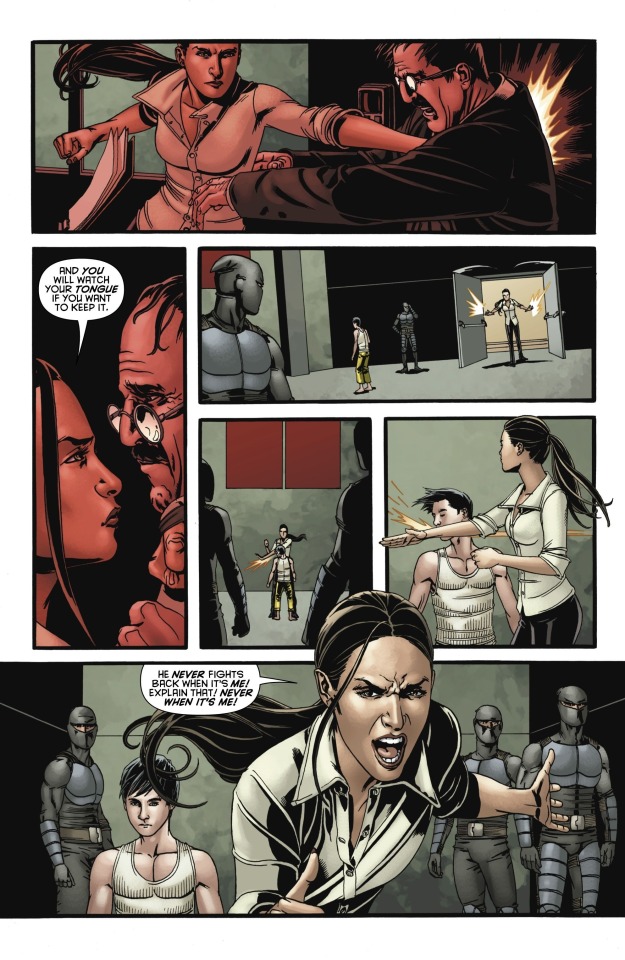
look at how small and tiny he is. just like the malnourished robin he once was. he’s 15 at this point.
this is them in issue 2
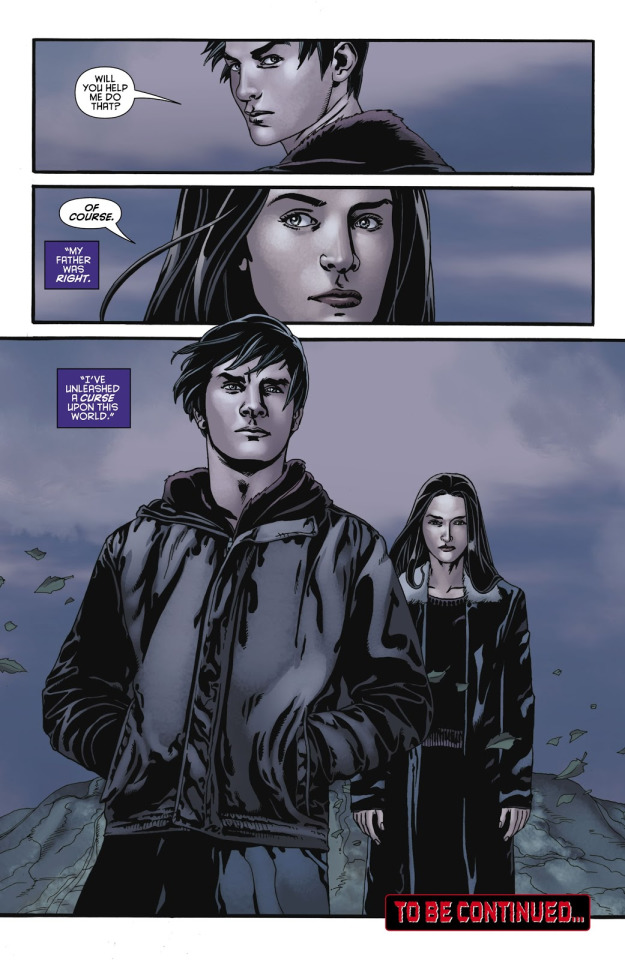
he’s clearly older here, but not by much, he’s at least 16.
and here they are in issue 3, you can see jason’s aging, he’s either still 16 or he’s 17
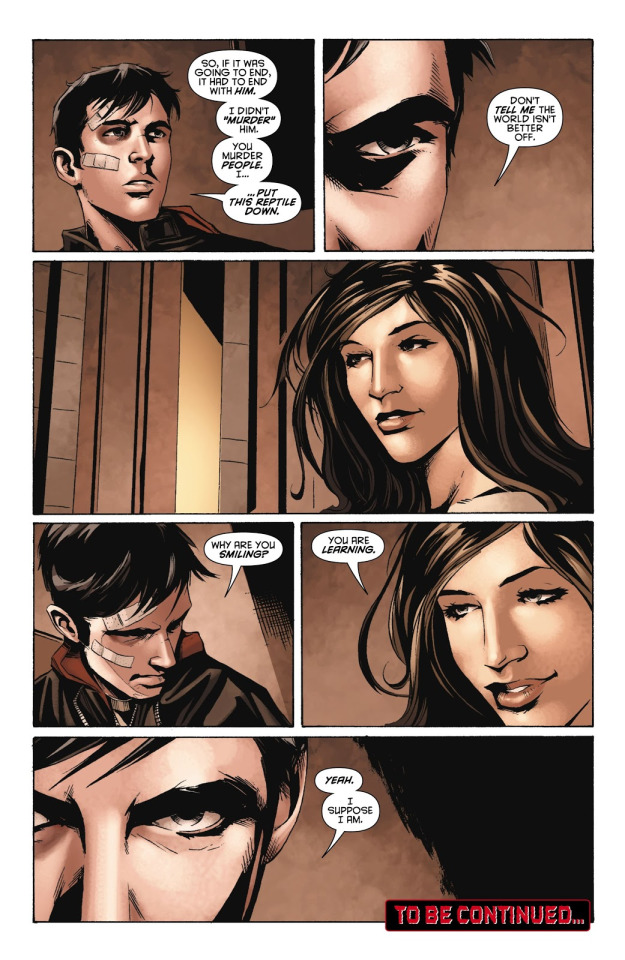
and in issue 4, he’s either a late 17 or an early 18 here at this point in the story.
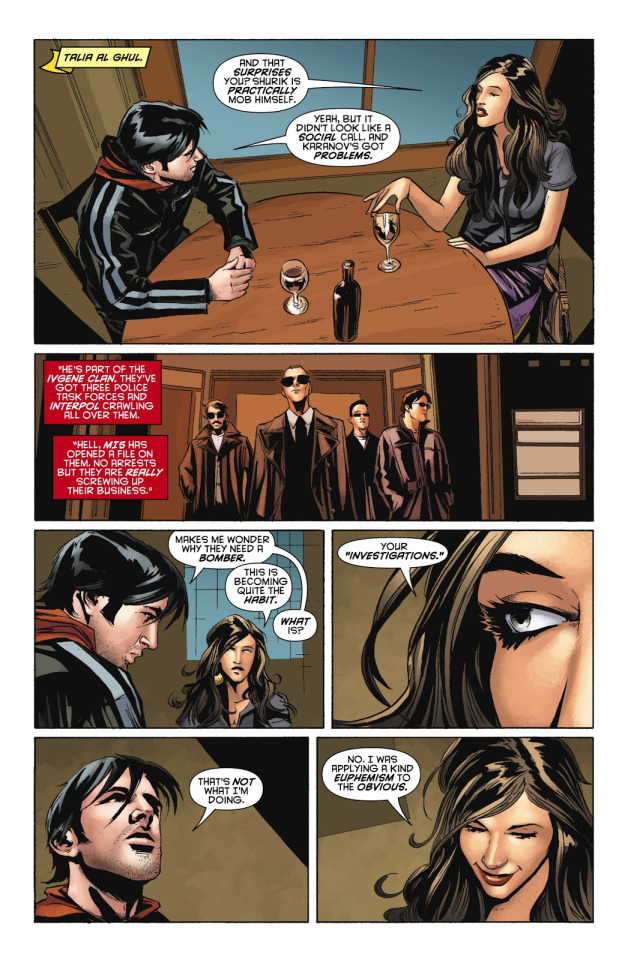
sidenote, jason with long hair and scruff is a LOOK!
and this is the Moment where they have sex in issue 6 when jason is 18
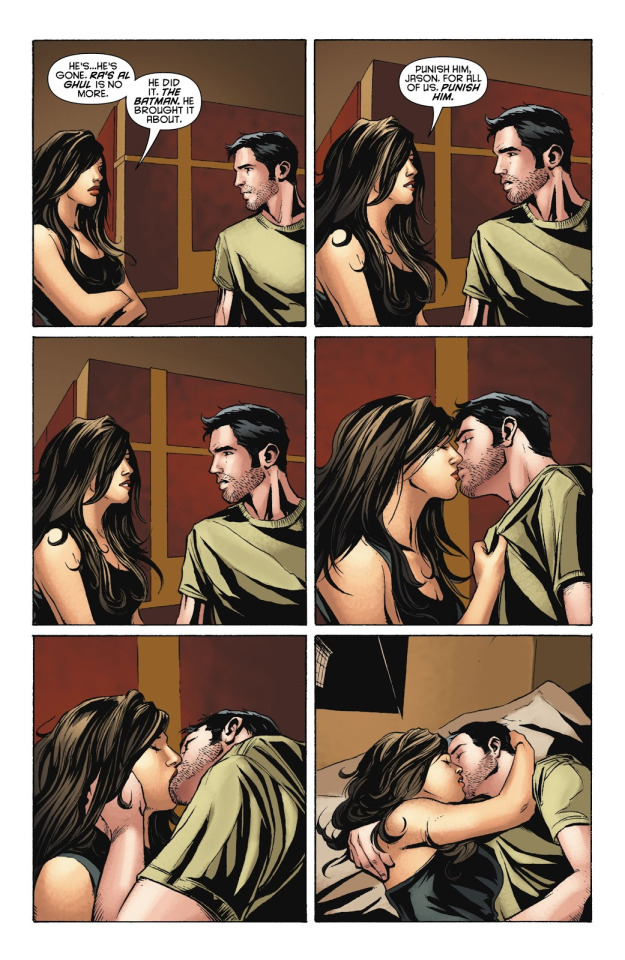
and the aftermath
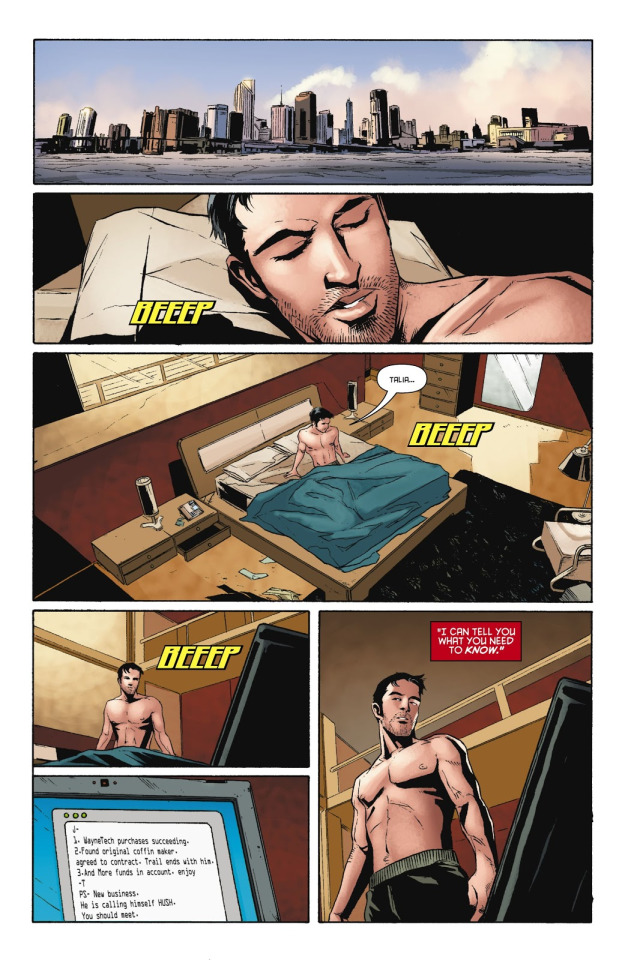
I’m pretty sure that’s a condom wrapper next to the phone.
compare jason in issue 1 to issue 6. he goes from a teen to an adult, and the transitions are obvious.
NOW
let’s get into the why.
it’s clear that talia is most likely using jason to get at bruce, but along the way she grows to care for jason.
it should be noted that at that point jason is still emotionally a mess from everything, and talia is dealing with her father’s death, so they’re two compromised individuals seeking comfort in one another. it’s cathartic. but that doesn’t make it healthy.
from the ages of 15 to 18 talia is jason’s primary caretaker. she doesn’t raise him, she’s not his mother, not biologically, legally, or technically. but she is a mother figure to him.
and talia is significantly older than jason, being in either her late 20s or early 30s
they aren’t unaware of their connection through batman, talia being his ex and jason being his adopted son
basically their having sex is a literal and figurative way of saying ‘screw you’ to the man
so their connection through bruce, age difference, power imbalanced relationship in the lost days story line, and their emotionally vulnerable states means that their having sex is unhealthy and it’s meant to be seen that way, it’s not supposed to be “hot” or good.
talia throughout the story manipulates jason into being the type of man bruce refuses to be, one who kills without hesitation.
but I wouldn’t say she takes advantage of him, not in the way you’d assume.
this isn’t a grooming situation, talia manipulates jason emotionally but not sexually. it’s messed up, we’re not contesting that
however, we will say that jason todd is legally an adult when talia has sex with him and it’s clear that it’s consensual on both their parts
jason’s not in a good head space when it happens but he is an adult physically, mentally and emotionally.
it’s not statutory rape or incestuous, but it is very very messed up.
the closest comparison I can make is, imagine during stephanie brown’s batgirl run when she was an 18 year old college student and wasn’t dating tim drake at the time, if bruce wayne found himself attracted to her and had sex with stephanie brown in spite of her being his son’s ex girlfriend who tim obviously was still in love with and would never be over, bruce being significantly older than stephanie, not acting as a father figure towards her, but a mentor of sorts over the years, and bruce knowing stephanie since she was a 14 year old teenage girl. illegal? no. messed up? very.
I’m aware an 18 year old jason’s not going to have the same maturity level as someone older, he’s still growing, but that’s not the point here.
it’s consensual and legal sure
but it’s also unhealthy and messed up for the reasons listed above
it’s interesting, that jason wanting to find his biological mother was the major catalyst that drove him to the events that led to his death, and after he rose from the dead he found a mother figure in talia
177 notes
·
View notes
Text
My Top 10 Favorite Fictional Couples
It’s been a really long time since I posted something here on Tumblr. I spend most of my time on the internet on Fanpop, Youtube, and Deviantart. Maybe I should try to get back into the swing of things here on Tumblr. I mainly come here to chat with my friend @keeloves rather than to post anything here. I mainly post my stuff on other websites. I hope you guys like this and let me know what you think but don’t be rude. Enjoy!
10.Odette and Derek (The Swan Princess)

With Odette and Derek, yes, they didn't get along at first and fought over the years, but there were subtle hints to them secretly liking each other. I mean, Odette, as a preteen was constantly following Derek and Bromley, like most girls at that age, did when it came to boys they secretly liked. Unfortunately, boys at that age thought that girls had cooties. Along with that, Derek as a teenager was shown to have some interest in her, though he wouldn't show it. When Bromley said that he thought Derek kind of, sort of like her, Derek didn't deny it, he simply said that he'd like her better if she'd lose at cards. He didn't deny he didn’t like her! Whenever a guy doesn't like someone and someone says they do, they'll instantly deny it, which he didn't do. Plus, if you noticed, when Odette and her father were leaving on their boat, at first Derek was just pouting, but then his face softened up, and he slowly turned to look at Odette leaving when he thought no one was looking (Right until she sling-shotted a tomato at him lol). Then we have them when they're grown up and I've said in the past, that Derek just wasn't good at expressing himself, which was why he said, "What else is there?" and not because he was superficial. Odette loved him but refused to marry him until he could express what he loved about her besides her looks. Derek obviously loved her for more than just her looks, if he didn't than he would've just gave up on her when it got difficult. Would you hunt down a dangerous animal, try to break a spell, and risk your life to defeat an evil wizard just for someone you loved only for their looks and nothing more? I don't think so! Derek learned how to grow and his love for Odette was what helped with it. He thought he'd be able to express his feelings for Odette but was so blinded by his love for Odette that he mistook the fake Odette for the real one. He was even suspicious of the fake Odette because he felt something was different about her, it was only when she presented to him the swan locket that he returned to the real Odette when he found her that he thought she had to be the real Odette. He even ran after Odette in her swan form, knowing she was dying, to find some way of saving her and to at least say some final word about his love for her and how he was sorry. Odette didn't say, "Derek... how could you?" because she knew that he meant the vow to be for her, he even says that the vow was for her, and she simply replied, "I know... I love you Derek..." before she died. But he refused to let her die and was willing to risk his life to save hers. He didn't care if he died, as long as she would live. He fought with every fiber of his being to save her, even though he was close to death himself, since Rothbart as the Great Animal was too powerful. But in the end, Derek did defeat Rothbart and his love for Odette was part of what helped bring her back and break the spell. The vow said he had to make a vow of everlasting love and prove it to the world. However, the spell didn't specify what it meant by “the world.” From how I see it, having a room full of people isn't the world but rather was just one person who was Derek's entire world to him, Odette herself. He finally said what else he loved about her, her kindness and courage, which was what broke the spell. Even after he killed Rothbart, Odette didn’t come back to life instantly. It wasn’t until he made his vow of everlasting love to the lifeless body of Odette that she came back to life. He learned how to express his feelings and appreciate the ones he loves while they're in his life because you might not always have them, so you should always cherish every moment with them while you can. They vowed to love each other far longer than forever.
9.Cory and Topanga (Boy Meets World and Girl Meets World)
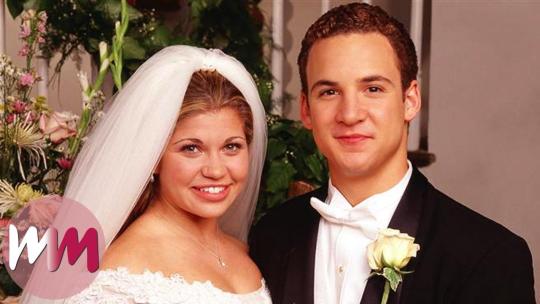
These two remind me of a modern-day version of Odette and Derek for many reasons. First being they’ve known each other since childhood, they couldn’t stand each other, they became attracted to each other because of hormones, Cory seemed to like her for just her looks at first and Topanga wanted to be loved for more than her looks, he proved he loved her for more than her looks, they had their problems, and would go on about how grand and enchanting their love for each other is. They are Odette and Derek to a T! I love them more because of how we do see more of them acting like a real couple with problems. We did get that with Odette and Derek in the two traditionally animated sequels but not to the same level as Cory and Topanga. They are one of the most iconic on-again, off-again relationships in TV history. However, unlike something like Ross and Rachel from Friends, who I do love as a couple, they aren’t dysfunctional or ever questionably unhealthy as a couple. They had problems where they would react like real people would, though Cory would overreact in some instances (Especially in the last few seasons), they’d stay apart for a realistic amount of time, and they’d work it out like two mature adults that love each other. They would do anything for each other and balanced each other out really well. He’s more of the living in the moment and having fun type that gets into a lot of trouble because of his reckless and naive nature while she’s the smart and responsible one that sometimes doesn’t know how to loosen up because of how controlling and perfectionist nature. They balanced each other's weaknesses with their strengths. They even stayed an amazing couple when they had kids in Girl Meets World, where they worked just as well as a team as they did as a couple and were great parents because of it.
8.Snow White and David (Once Upon a Time)

These two have incredible chemistry and part of the reason is that the actors, Ginnifer Goodwin and Josh Dallas, are actually married in real life with kids. It was because of this show that they met and their love blossomed. Ginnifer actually said she never planned to get involved in that way with a co-star but love changed her plans. This couple is so well-done and passionate. These two developed their relationship and didn’t just instantly fall in love. Hell, when they first met, she was robbing him and hit him in the face with a rock. When he caught up with her, he trapped her in a net. Not exactly a traditional fairy-tale romance meeting. These two are adorable with how dedicated they are to one another and how they will always find each other no matter what. While they didn’t have as many conflicts as the other couples on the show, they still had their conflicts and would work through them. They are willing to do anything for each other but would also sacrifice their own happiness for the sake of others. They even share the same heart! I just absolutely ADORE these two and the fact that the actors are married with kids in real life makes me love them even more. Their chemistry is just so enchanting that I can’t help but gush about them so much!
7.Regina and Robin Hood (Once Upon a Time)
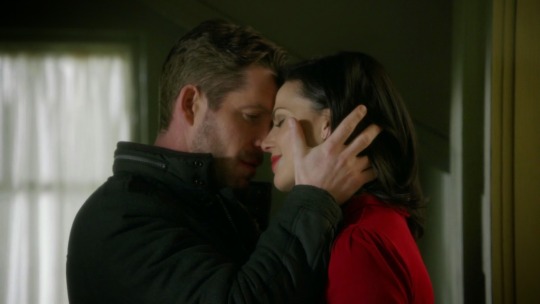
These two are my absolute favorite couple on Once Upon a Time and they're just absolutely amazing. I love how even though they didn't get along at first that it's clear that they had a strong chemistry. Regina was afraid of falling in love because she was afraid that she'd lose her happiness because it's happened before. Being the Evil Queen, she was used to losing things she loved. However, she felt such a strong connection between her and Robin Hood that she even allowed him to keep her heart (literally) and even kissed him. She was even able to feel such a strong passion for him without her heart, that should tell you something. Even with the whole Marian thing, it's clear that the two still adored one another and just want to be together but things keep on happening. Finally, the two of them were together once again because it's clear that they're simply meant to be, the pixie dust even said so. Plus I just love couples where a woman is evil (or rather was) and the man is a good guy. That probably explains why the next couple is on this list. Unfortunately, these this romance would be torn apart because of how Robin was killed trying to save her life. Their love was so amazing that he was still with her and in a sense, he was with her to help her be able to move on with her life and be happy. Their love was so incredibly strong that even their clones fell for each other. Plus, this is an interracial romance, which is something we need more of in media. 6.Batman/Bruce Wayne and Catwoman/Selina Kyle

This is ironic because my least favorite comic book couple (and one of my least favorite couples in general) is The Joker and Harley Quinn. Anyway, if The Joker is Batman's villainous opposite, Catwoman is Batman's villainous similarity. Yes, I got that from the Nostalgia Critic video! Anyway, both of them are very similar because both of them have tragic backstories, dress up in skintight outfits, have style to them, and operate outside of the law. However, Batman fights crime and is a good guy, while Catwoman will both fight crime and commit crimes. Batman has more of a moral code than Catwoman and tries to influence her. He tries to deny that there is an attraction and strong chemistry between the two, but of course, there is no hiding his true feelings for her. Catwoman is obviously very flirtatious with Batman and uses his attraction to her to her advantage. However, it's clear that even when she has nothing to gain from it, she'll save him from danger because she loves him. There have been many different interpretations of these two that are pretty interesting. In the comics, Selina came from a tragic life but was middle-class and later lived off the streets, as opposed to the animated series where she's a wealthy upper-class woman like Bruce. In Batman Returns, she's more of a psychotic... well, more than usual. Bruce thinks that he can save her but realizes that he's insane too and that they both could use some saving. These two probably have the most complicated relationship EVER! Sometimes they know each others identities and other times they don't. But either way, they're still amazing. 5.Shrek and Fiona (The Shrek Franchise)
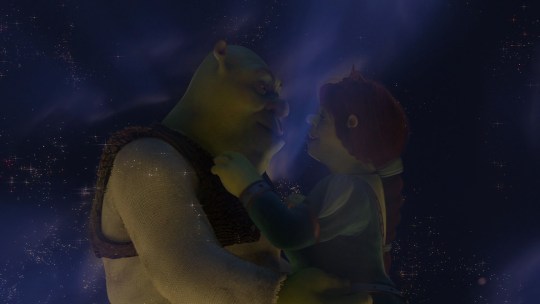
Talk about the opposite version of Belle and Beast. Instead of the ugly monster turning into someone beautiful, it's someone beautiful turning into the ugly monster. But you know what? That's part of what makes it so unique. Fiona no longer cared what she looked like because she had finally found the one she loved and he loved her for who she is on the inside, not the outside. The two of them have a really strong chemistry and it's clear throughout all of the Shrek movies. I love how Shrek was even willing to give up his species to make Fiona happy but it turned out that wasn’t what she wanted. She wanted to live happily ever after with the ogre she married because that's the one who helped her change and become the person she was. The two of them are incredibly dedicated to each other but they also act like a real married couple. They’d have their fights and arguments but in the end, would do whatever they can to make it up to each other. They even had kids together, which is always a great symbol of love, unless it ends in divorce. However, in this case, it just makes their love for each other stronger because it just means there's more of their love to go around and their love created three little miracles. 4.Danielle and Henry (Ever After)

This is definitely the best version of the couple of Cinderella and Prince Charming because we actually see them talk about their dreams/interests and get to know each other. They have a clear instant chemistry from the very moment that they met each other. The two of them are very dedicated to each other but they actually do start off being friends and it wasn’t just, "I wanna marry you." The two of them were friends that clearly had a thing for each other and would later admit that it's love. Unfortunately, Danielle didn't want to admit it because she was pretending to be a high-class lady when she was really a servant girl. She was afraid of being rejected by Henry, which he did because she lied to him. However, not too long after, he went after Danielle and begged for her forgiveness because he realizes how stupid he was for almost losing the most important thing in his life that he loved more than anything, her. I love how we do get to see them get to know each other with such amazing scenes. Neither one of them is shown as the weaker one but instead as an equal team. They can both take care of themselves and do save each other. They're a great couple and clearly deserve all the love that they get. 3.Quasimodo and Madellaine (The Hunchback of Notre Dame 2)
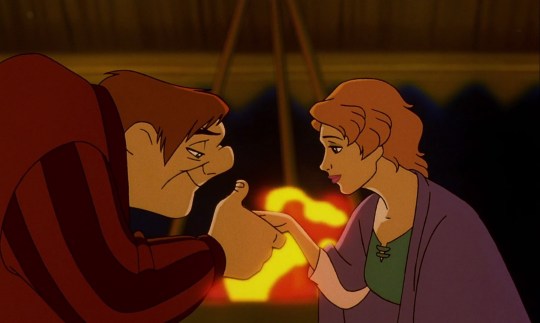
Such a tragically underrated couple that deserves a lot more love, despite coming from a bad movie. These two just have instant chemistry from the very beginning. Madellaine acts silly and feels self-conscious, but Quasimodo finds her charming and he even gets in on the silliness. At first, she was frightened by his deformed appearance but later sees what a kind-hearted and sweet soul that he was, so she gave him a chance. He showed her so many new things that happen every day that she never noticed were so amazing. I love how both have been abused and have their insecurities and helped each other work through them. Madellaine was very insecure and didn't feel particularly pretty, smart, or capable of anything great. However, Quasimodo thought that she was beautiful, clever, funny, and amazing and helped her to see all of this. Madellaine managed to look beyond Quasimodo's appearance and see the true beauty inside of him. To her, on the inside anyway, he was the most beautiful person in the world. I think they're an even better message of beauty lying within than Belle and Beast or Shrek and Fiona because neither had to change their appearance to be with the other. They loved each other for what was on the inside and the only thing that changed was how they viewed themselves because of their love for the other. Madellaine loved Quasimodo so much that she would rather have him hate her than for the villain to hurt or kill him. That's true dedication and absolute true love. Their love is a beauty that can't be denied. 2.Jack and Rose (Titanic) & Noah and Allie (The Notebook)

It's hard to decide between these two because both couples are really similar but do have different outcomes. I mean, both are about poor guys who fall in love with rich girls that are having their lives decided for them and are about to be in a loveless marriage until their true loves come along. However, Jack and Rose end in tragedy because Jack dies saving Rose's life. Noah and Allie, on the other hand, actually do get married and live a long and happy life together. However, both of them end in a very similar way. Rose dies as an old woman and is reunited with Jack and both Noah and Allie die at the same time when they're old. The Notebook is actually based off Nicholas Spark's wife's grandparents love story, so that's very romantic. I love how both couples try to keep their love alive. Jack is dead but Rose keeps him alive by taking his last name and never forgetting him because he helped make her the person she always wanted to be. Someone who wasn't afraid to define her own destiny. But his love also gave her the strength to be able to move on, marry someone else, and start a family. Allie in her elderly age had dementia, so she was having a problem remembering things, so Noah would try to keep the memory of their love for each other alive. Both couples are very well-written and romantic as can be. Both couples make people ball their eyes out and it's clear to see why. However, there is one couple that is better than them. 1.Carl and Ellie (Up)
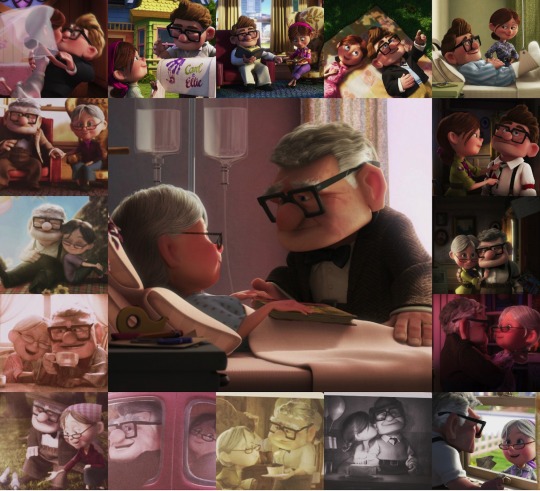
There is absolutely no doubt about it that Carl and Ellie are the best fictional couple to ever come into existence! We don't get to see the story of how they fell in love but we did get to see their married life together. They were friends as kids, so of course, they knew a lot about each other and were really close. They grew up, fall in love, got married, and just lived their lives together. It gets to the point of what all of us looking for love want. To be with someone to have a life with, be your best friend, make memories with, grow old with, and spend the rest of your life with. You can see how much these two just loved each other and how whenever they had a problem they managed to get through it because they worked as a team like a real married couple would. Carl felt bad that Ellie never lived to have the adventure she dreamed of but it turned out that he gave her an even greater adventure, their life together. His love for her and the life they built together was what made her die a happy woman. If you look through the scenes she’s in from the movie, there was hardly any moments when she wasn’t smiling because she was just so happy to be with the man she loved, same with him. I love how both of them brought out the best in each other, despite being both different and similar. He's shy and awkward while she's energetic and talkative. But both of them have such an amazing sense of adventure. Seeing their life together is always the best part of the movie and are clearly, in my opinion, the best couple with the best love story of all time. While I think the movie itself is overrated, if it wasn’t for this couple, it never would’ve won the Oscar for Best Animated Picture (Which I felt should’ve gone to The Princess and the Frog). This couple is relationship goals, especially for me, except I want to have kids and will adopt children if I need to.
#carl and ellie#up#disney#pixar#disney pixar#pixar's up#titanic#rose and jack#jack and rose#The Hunchback of Notre Dame#the hunchback of notre dame II#the hunchback of notre dame 2#quasimodo and madellaine#noah and allie#the notebook#ever after#cinderella#cinderella ever after#ever after a cinderella story#danielle and henry#shrek#shrek and fiona#batman#catwoman#batman and catwoman#bruce wayne and selina kyle#bruce wayne#selina kyle#fiona#princess fiona
31 notes
·
View notes
Text
DC’s Nuclear Winter Special (Comic Book Review)
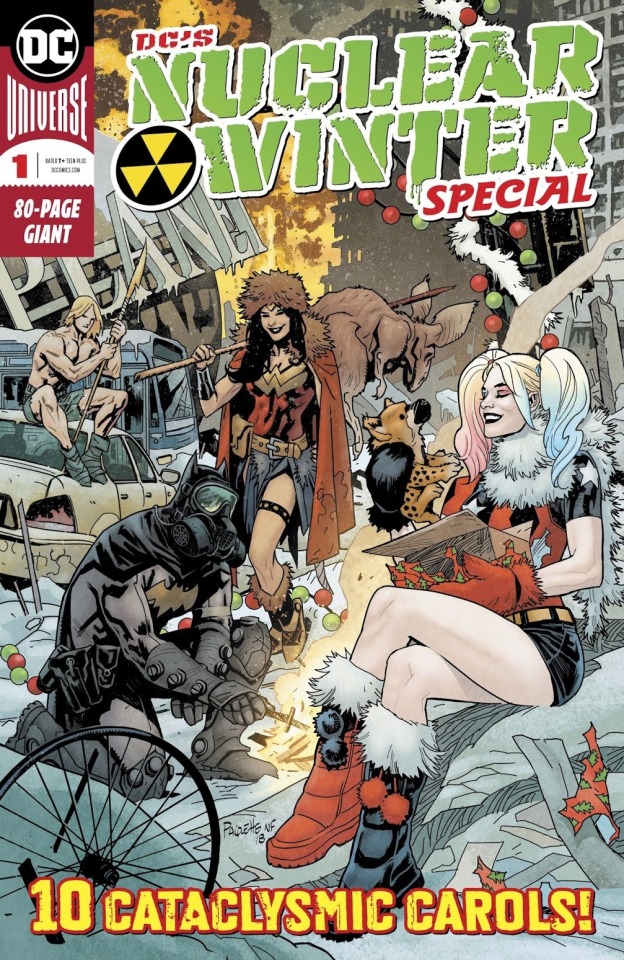
There are plenty of reasons to not feel like getting into the holiday spirit, many of them valid and more apparent in the world at large this year in particular. So in the spirit of a time where it can feel like the world is ending, I’m going to recommend DC Comics’ 80-page holiday anthology special for this year, the Nuclear Winter Special. Featuring ten different stories focusing on some of the DC Universe’s greatest heroes from across time dealing with struggles in varied post-apocalyptic environments and connected to the holiday season in some way.
The ten stories and creators are the following:
Rip Hunter (writer: Mark Russell, art: Mike Norton, colors: Hi-Fi, letters: Daron Bennett)
Batman 666 (writers: Collin Kelly & Jackson Lanzing, pencils: Giuseppe Camuncoli, inks: Cam Smith, colors: Romulo Fajardo Jr., letters: Clayton Cowles)
Superman One Million (writer: Steve Orlando, pencils: Brad Walker, inks: Drew Hennesy, colors: Nathan Fairbairn, letters: Clayton Cowles)
The Flash (writer: Jeff Loveness, art: Christian Duce, colors: Luis Guerrero, letters: Tom Napolitano)
Supergirl (writer: Tom Taylor, breakdowns: Tom Derenick, art/colors: Yasmine Putri, letters: Deron Bennett)
Aquaman (writer: Mairghread Scot, art: Dexter Soy, colors: Veronica Gandini, letters: Steve Wands)
Firestorm (writer: Paul Dini, art: Jerry Ordway, colors: Dave McCaig, letters: Dave Sharpe)
Kamandi (writer/pencils: Phil Hester, inks: Ande Parks, colors: Trish Mulvihill, letters: Steve Wands)
Catwoman (writer: Cecil Castelucci, art: Amancay Nahuelpan, colors: Brian Buccellato, letters: Josh Reed)
Green Arrow (writer: Dave Wielgosz, art: Scott Kolins, colors: John Kalisz, letters: Alex Antone)
[Full Review Under the Cut]
I’ll mostly be going out of order for how I discuss the stories in this anthology special. However, the first two in the book are worth grouping together for discussion, the Batman 666 and Superman One Million stories. Both expansions on characters from alternate futures presented during Grant Morrison’s runs on Batman and JLA, respectively.
The story of Damian Wayne as the future Batman wandering the frozen wasteland while pondering if his dedication to his father’s ideals still means anything in the remains of the world, when he’s one of the people who ruined it. Multiple stories in this special play on the idea that time stopped really meaning anything in the post-apocalyptic landscapes the characters are left in, so they’re made to focus more on the essence of what the holidays represent. Kelly, Lanzing, Camuncoli and Smith bring in the idea of family togetherness by introducing Damian’s grandfather, Ra’s Al Ghul, into the story with the way the fight between the Bat and the Demon resolves coming down to the end of the world helping Damian put where his values are in perspective.
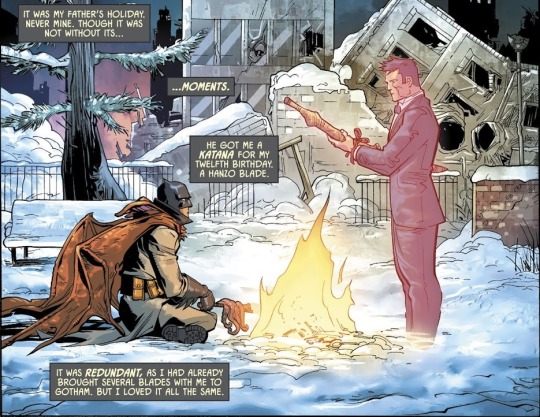
Superman One Million’s story focuses on togetherness as well, but from another perspective and adding in the idea of the importance of memory. While Kal Kent, the Superman of the 853rd century, is highlighted in the table of contents for this issue, his segment of this issue absolutely belongs more to J’onn J’onzz, the Martian Manhunter. If this issue indicates Orlando’s approach to writing J’onn, then his upcoming miniseries focusing on the character is going to be something special. How canon anything in this special is meant to be taken loosely at best, but I like what this short story adds to J’onn’s character history when Kal Kent goes back in time to stop a time travelling villain from destroying the Superman Dynasty before it starts. The sequence where Kal gives J’onn back the memories of their past encounter the were removed for the sake of preventing paradoxes among the most heartwarming moments in a book full of them.
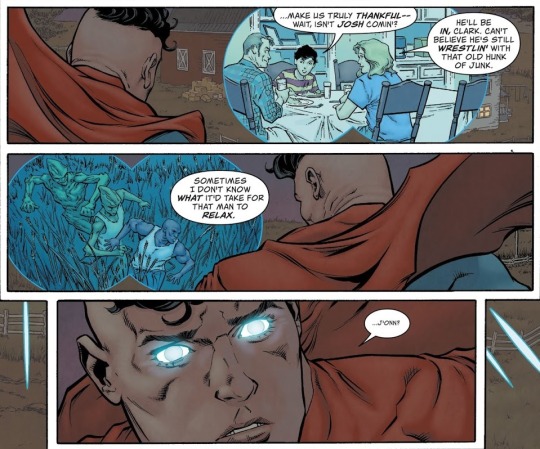
On the topic of stories that add interesting new details to the featured character’s background, the Kamandi story by Phil Hester does this by way of tribute to the character’s creator, Jack Kirby. It takes the already heightened world that Kamandi inhabits and places this adventure within a framework that calls back to the stories of both Hanukkah and the Nativity. The Hanukkah elements are mostly in play as something Kamandi recalls from his time growing up in a bunker with his grandfather telling him stories. As far as I know, this is the first story in the character’s history to feature the idea that Kamandi is of Jewish decent. In addition to that neat detail, there are ways that this story feels more complete than a couple of the others within this issue as it manages to set up all its necessary elements quickly and executes paying them off in a satisfactory manner within the limited page count.
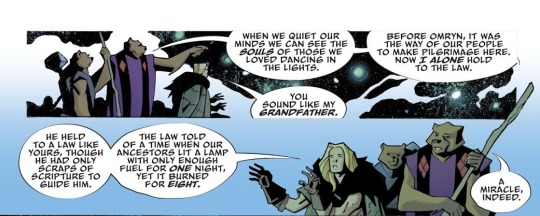
Another story that makes effective use of its short page count is the Firestorm story, “Last Christmas.” The brief tale of Ronnie Raymond and Professor Stein having a final confrontation with the android Nuclear Family as they face their last Christmas ends up weirdly poignant and heartwarming. Dini and Ordway work together to balance the tragedy of the supervillain family with them still being a genuine threat. That tragedy also reflects on the kindness of Ronnie and Stein as they figure out how to save the day while letting the Nuclear Family’s final Christmas be a merry one in the end.

Two more stories that contain some interesting parallel structures are the Catwoman and Supergirl stories. Each one puts the focus heroine in a parental role and shows how that keeps them inspired to action, even in the face of a world that’s falling apart. Catwoman’s story starts with Selina in a position where she mainly seems to be using her role as guardian to the daughter of her longtime friend, Holly Robinson, as a reason to remain self-interested in the dystopian Gotham. In a time when people are forced to stretch whatever resources they manage to get their hands on for as long as possible, Selina debates her charge about whether they should try to help others when their own supplies keep running low. Eventually, Selina gives into her better nature and it inspired to play the role of Santa Claus by way of Robin Hood.
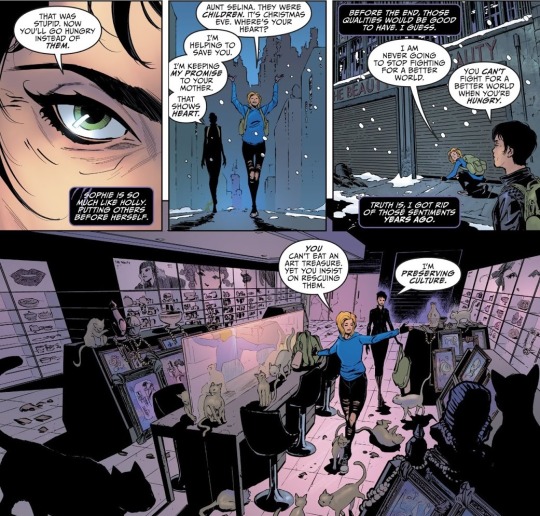
Writer Tom Taylor went to Twitter to ask people not to read the table of contents of this anthology, so they wouldn’t spoil his Supergirl story for themselves with its title. Since this easily makes the strongest contender for best story in the book, I’ll oblige by not giving away the ending either. The older Kara Zor El in this story looking after her adopted daughter in the “Not Distant Enough Future” journeying across the blighted Earth to find some place she can charge up her powers again is a compelling start to the story. The ending of the story builds up to Kara reflecting on a simple idea. In the face of the end, she has a choice to either perpetuate the cycles started by those who came before her or do something better. If you know anything about the Super-family, what her final choice ends up being won’t come as a surprise.
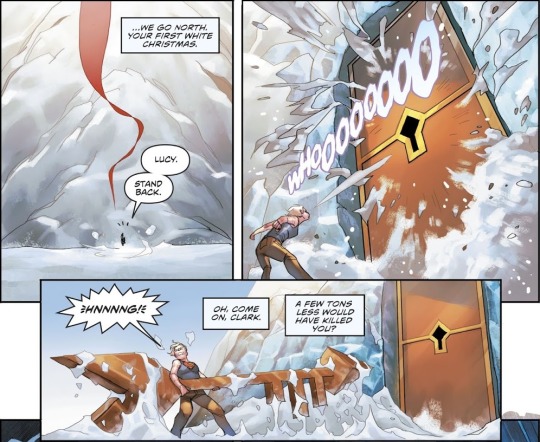
While I don’t think any of the stories in this special are bad, there were three I felt fell short of the standards of most of this issue. The Flash and Aquaman stories, while playing on the same themes of hope in the face of a hopeless existence that permeate the rest of this issue, are the ones that stretch the holiday connection the most. Though both still serve as pretty good highlights for their focus heroes. The choice of focus hero was my main issue with the Green Arrow story. I’ve never particularly liked or disliked Oliver Queen as a character, but this story seems to require some type of investment in him to get something out of him being grumpy at a future Justice League’s Christmas party. Though the actual weakest part of the book is the framing device with Rip Hunter, which doesn’t seem to serve much purpose related to the other stories beyond being a framing device.
DC’s Nuclear Winter Special showcases the present creators pulling some great material for the featured heroes within the setup of the titular motif. There are certainly people reading this who will get more out of the stories I was dismissive towards and the average quality of the ones I’ve highlighted is strong enough to give this 80-page special a strong recommendation as a way to get into the holiday spirit with some exemplary superhero storytelling.

If you like what you’ve read here, please consider throwing some support my way at either Patreon or Ko-Fi at the extension “/witswriting”
#DC Nuclear Winter Special#Wit's Writing#Comic Book Review#Christmas#Christmas comics#comic books#comics
15 notes
·
View notes
Text
Wonder Woman: on female characters in comics PART 2
part 1, 2, 3
Please bear in mind that English is not my first language!
Part 2: Useless pretty, sexy bad and second-hand skirts
Summary: A classification of female characters in comics.
Before we get going, an important note: this is not character bashing. I may sound extremely critical and snide at times, but it doesn’t mean that I hate these comics or these characters or even these authors! Batman, for instance, is my absolute favorite fictional character. I also have the biggest soft spot for Harley Quinn and Lois Lane. However, it doesn’t mean that it gives them a free pass. Quite the opposite, in fact.
Text under the cut.
In the previous chapter, we’ve touched on ‘fridging’ and why it’s not cool (ha-ha see what I did here). Due to particular conditions, women were pretty much absent from the picture and therefore, could not influence how women were portrayed for a while. Male visualization of women turned out to be quite… limited. Reading comics, I have noted that female characters in the comic books can generally be divided into four categories. There are, of course, some exceptions, but the percentage is far too small. As I thought about these categories, I’ve realized that three out of four are constructed though the sexism of the superhero narratives, while the last one is in a constant struggle against it. There are damsels in distress, femme fatale, gendered spin-offs and the female superheroes. Some characters fluctuate from one category to another, or fit into more than one. Let’s talk a bit more about the first three, so it’ll become clearer, why the female superheroes are so important for representation of women.
The first category is the damsel in distress: the mother or the aunt, the girlfriend, most often powerless.

It includes such characters as Lois Lane, Vicky Vale and Iris West. Interestingly, all three of them are journalists, which arguably justifies their rash behaviour, which often lands them in trouble. They are nice, generally understanding, but quite often annoying, as they manage to land themselves in trouble yet again. It’s like they don’t understand that they should just sit down, because they either land in villain’s hands or they pressure the hero to quit heroing. With time, they have become snarky and easy-going, and obviously able to take care of themselves (until they aren’t) but the truth is, they are indistinguishable. They are cut out from the same piece of cardboard, as precious time for character development cannot be wasted on them, and they serve as conscience, motivation and ‘someone to come home to’. They are the classic ‘women in the refrigerators’ (Simone, 1999) and their interests and plot arcs rarely transcend the love interest, or in case of Iris and Aunt May, the relative of a superhero.
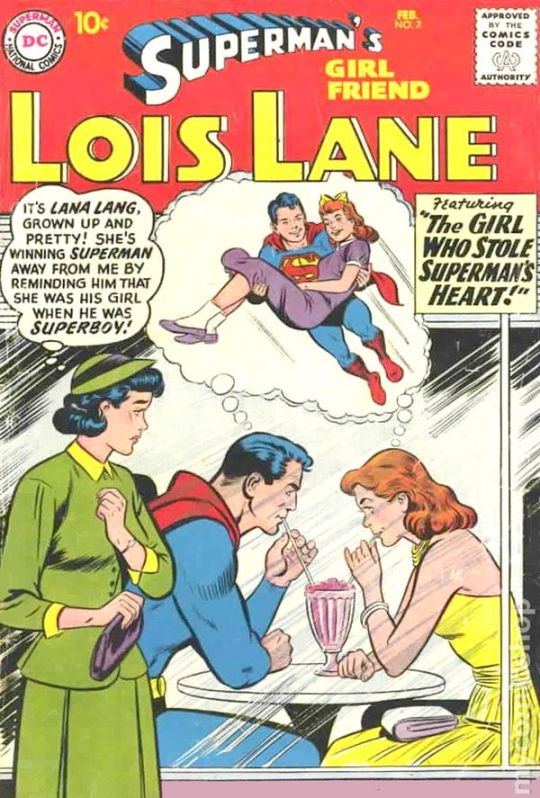
Probably the most notable example will be the Injustice franchise, where Superman becomes a tyrannical dictator, stricken with grief after the death of Lois, who has also been pregnant with his child at the time (Injustice: Gods Among US [I] #1, 2013)*. The comic series depicts the extent of Superman’s psychological trauma, as he is deceived by the villain into killing Lois with his own hands, thus, focusing not on the tragedy itself, but solely on Superman’s reaction to it. By the end of the series, the reader still has no idea, what kind of person was Lois. She is not important, what is important is that now the superheroes have an excuse to fight each other. Nobody in the comics really mentions her. The only time someone does, it is to reprimand Superman for his actions, all while Superman plans kidnapping Lois from another dimension because she’s just replaceable. Of course, this isn’t a story about Lois, but if a main heroine of Superman family cannot get a decent dealing, what’s there to hope for, for a lesser female character? We do not see her family or friends. She doesn’t really have a life outside her husband and it is precisely her connection to Superman that gets her in trouble. I might be picky, but having a joint surname (Lane-Kent, West-Allen, Watson-Parker) isn’t enough of a feminist statement for me.
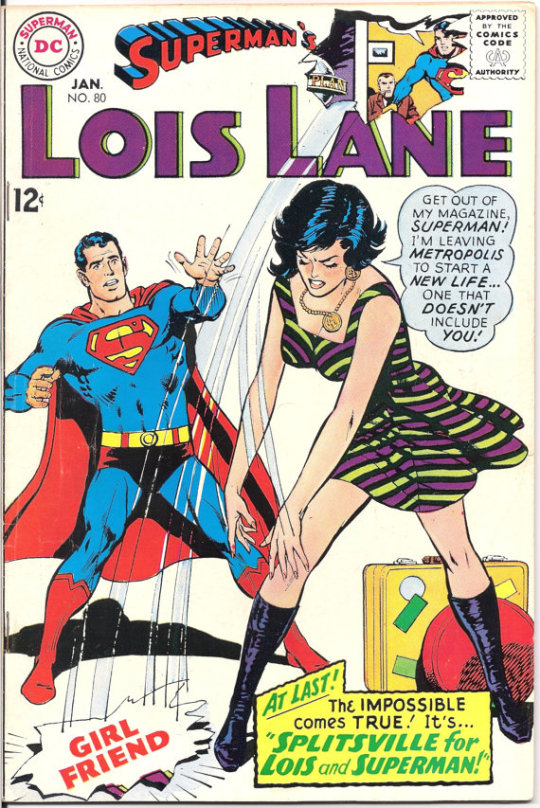
The second category is the femme fatale or a seductive villainess, such as Talia al Ghul, Poison Ivy and Catwoman.

Most often, she is attracted to the superhero and tries to sway him of his righteous pass with her female charm, while he treats her as a lesser threat than male villains, because he believes she can be ‘good’ again. If she rejects the ‘good side’, she gets further from humanity and, thus, loses her chance for sympathy, absolution and happiness. Seductive villainesses often find themselves in a situation where they have to resort to their sexuality to distract their opponents or to persuade men to work with them. They are reduced to sexual objects for the male characters and by extension for the spectator, meaning the reader of the comics (Mulvey, 1975: 62).

They perform the role of the seductresses, trying to lure the hero from the path of righteousness and virtue. While being positioned as the erotic object, they are at the same time completely dehumanized. Talia turns from a villainess in love, who cannot decide on her loyalties, into a full-fledged assassin, and she is portrayed as a cold-blooded maniac, who drugs and rapes Batman, brainwashes him, clones their son and kills him (Robin: Son of Batman, 2015). In Harley’s absence, Poison Ivy does not value a human life at all, manipulates people and is more plant-like than human (Austin, 2015: 294).
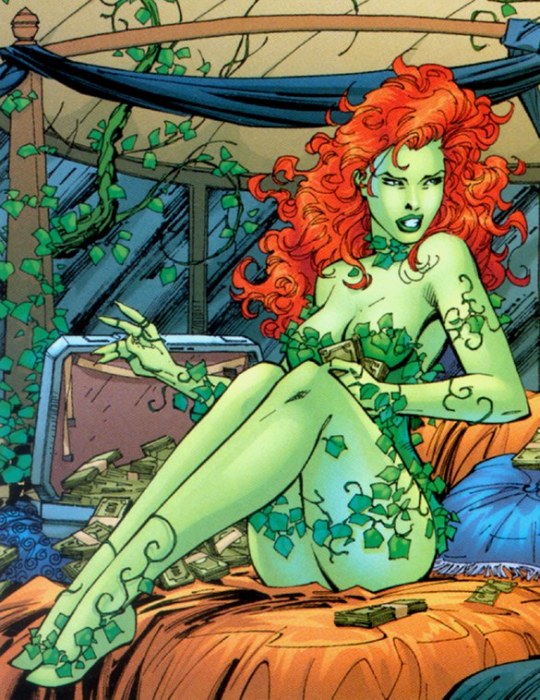
The relationship between female empowerment and male disempowerment can be described as dichotomous. There is a prevailing narrative that a woman with power is a threat (Austin, 2015: 286). She defies male dominance and dares to enforce her own rules and focus on her own desires. The man tries to regain control over the dangerous woman. (Mulvey, 1975: 67) Notice how generally these women have a good cause at heart: Talia’s aim is to preserve the planet from disastrous actions of human kind; similar to Poison Ivy, who is concerned with flora; Catwoman protects felines and girls and women of lower classes and is essentially a version of Robin Hood. Harley Quinn has a mental illness, and copes with it by adopting animals and looking after them. Killer Frost is a heat-vampire and when she finds a cure (Firestorm) she pretty much stops attacking people, because she was doing it only to survive. Another interesting observation: it is their connection to men that pushed them to extremism. Talia is manipulated by her dad (who assures her of his love for her to save him on numerous occasions, but in the end kills her and uses her body to store his consciousness (BTAS)). Pamela Isley is nearly murdered by her male colleague. Selina is sexually abused by men. Killer Frost is locked up in a working reactor. I would assume everyone knows what’s the deal with Harley. Most often it contrasts with the actions of the hero: he tries to help her, make her normal again, fix her. This perpetuates a stereotype of how women are wrong about their prejudice against men, because ‘not all men are like this’. What is also inevitably and unknowingly created is that these women do not need fixing, it would change them at core. They aren’t even evil, as much as they would only help a cause if they believed in it. Even if they try to change for a man, they relapse: but through relationships with women, they are healed and they are able to embrace their power and be good, be evil, be something in the middle – and being true to themselves at the same time.
Obviously, I am going to talk more about Harley Quinn. In the case of Harley Quinn, Joker physically and psychologically abuses her, manipulates her, makes her lose her job and her degree, drives her mad and so on. When she exercises her agency and comes close to killing Batman, successfully trapping him – something Joker himself had not succeed in – he angrily sets the boundaries between himself and Batman, their relationship, and Harley, who must only follow orders (Mad Love #8-72, 2009). Man games are one thing, and woman must never intrude! Harley learns it the hard way – it costs her almost every bone in her body. Joker ‘owns’ Harley and when she leaves him, he is livid and immediately sets to return her into his possession (Gotham City Sirens #10-26, 2011), exemplifying how Joker is unable to accept Harley’s existence beyond him (Austin, 2015: 285). On the other hand, Batman tries to establish his authority over her by bringing her to justice and rehabilitating her. He perceives her as a victim and someone, who despite being as dangerous and cunning as Joker (Mad Love #8, 2009), still needs saving. Harley is caught between two men, and while Batman is genuine in his desire to get her away from Joker (plus he doesn’t have romantic feelings towards her), it’s a no-win situation for Harley, because she can’t break away from her dependence issues. Enter Poison Ivy. By making Harley immune to all toxins, she both makes Harley stronger and cancels her main advantage over her. Poison Ivy doesn’t see Harley as a sidekick or a child who doesn’t know any better – she makes it possible for Harley to keep up with her. It also transforms Poison Ivy’s character. From then on, writers have abandoned the trope of Poison Ivy’s occasional boring crush on Batman.
The third category is the ‘spin-off franchise baggage’ (Scott, 2013). It is quite easy to spot this type of characters, as their names are literally the derivative of their male (the original) counterpart: Batgirl, Supergirl and She-Hulk.

She does not have a sound or at least unique backstory, she is essentially the female version of the character, but secondary to him: weaker, less interesting, less popular and less developed (Fretheim, 2017: 32-33). Supergirl is another survivor of Krypton; She-Hulk was created literally by blood transfusion from Bruce Banner to his cousin, Jennifer Walters (they wanted to give her his rib, but it sounded vaguely familiar for some reason).
Sometimes such a character can break out of the limited space, provided by the legacy of the common root of the aliases (Bat-family, Super-family), for example, Barbara changes her line of activity after injury and Batgirl becomes Oracle, a character in her own right, giving voice to a readership with disabilities. It is also an example of how ‘fridging’ can be turned into a positive character development. In the Killing Joke, Barbara is harmed only because of her association with Jim Gordon, and the thematic purpose of her injuries is to provide emotional stakes for Batman. Nevertheless, she doesn’t stop being a hero and doesn’t become a liability. She is unique and interesting to read about. However, while it is possible, it is also reversible, as in 2011 Barbara puts on the Batgirl suit once again (Cocca, 2016: 78). Rarely, she can become more popular than the original hero, like Hawkgirl.
In terms of visual representation, it is quite easy to retrace sexual discrimination in the way that the male and female counterparts are portrayed. Although men with super powers do not need muscles to lift cars, they look jacked, a bit too much really. Hulk is positively ugly. Women, on the other hand, cannot let themselves be caught looking a tad less than ready for a Playboy photo-shoot.
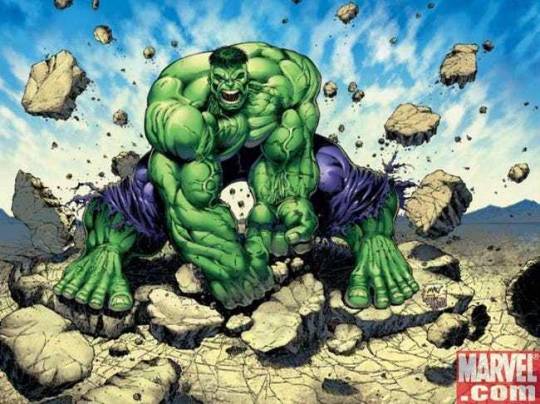
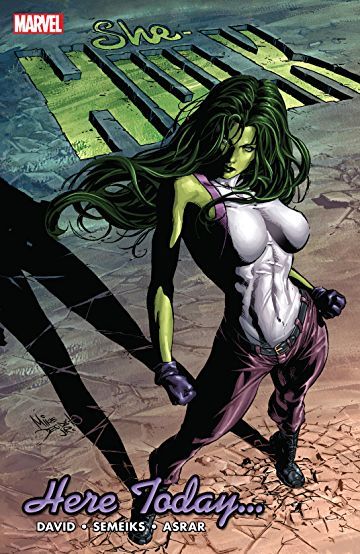
Where male superheroes are embodying the ideal of masculinity, they are fit, muscled, and attractive – they are essentially the asexual subjects, while even their own gender-bent versions are put into suggestive poses and are given revealing outfits and heels (Batman: The Drowned #1, 2017).

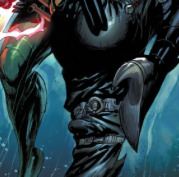
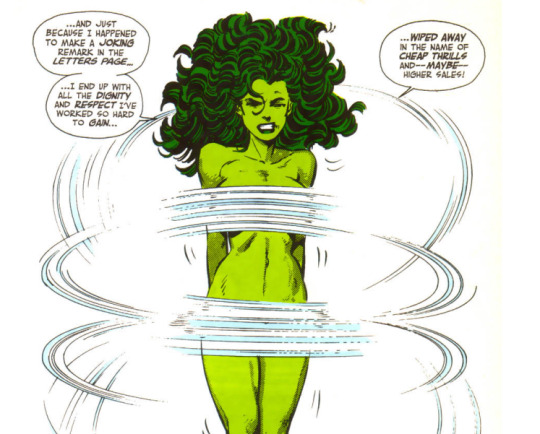
Last but not least, the category of the female superhero. She is created as a distinct character, with her individual backstory and a set of powers. She is Wonder Woman, Starfire, Black Canary.
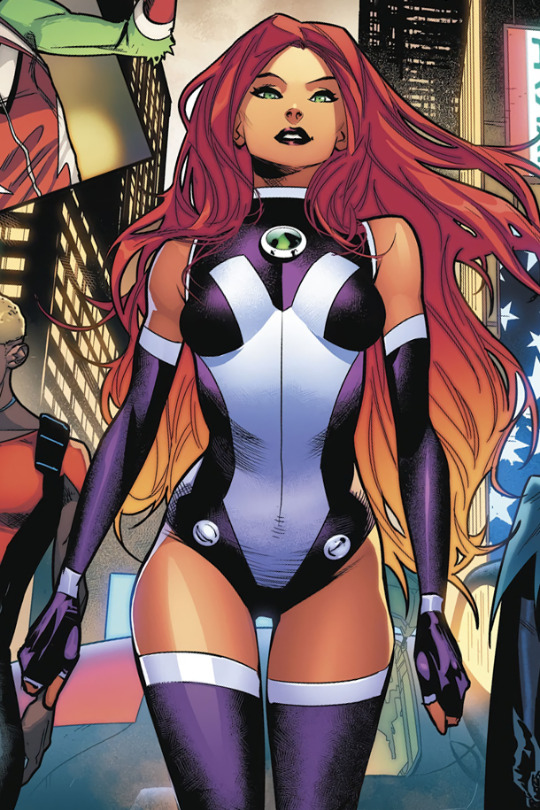
The female superhero has her own backstory and her own set of powers. This doesn’t mean that they’re saved from the male gaze, unfortunately. The image above is one of the most modest costumes of Starfire I have found. This is particularly Starfire’s curse:
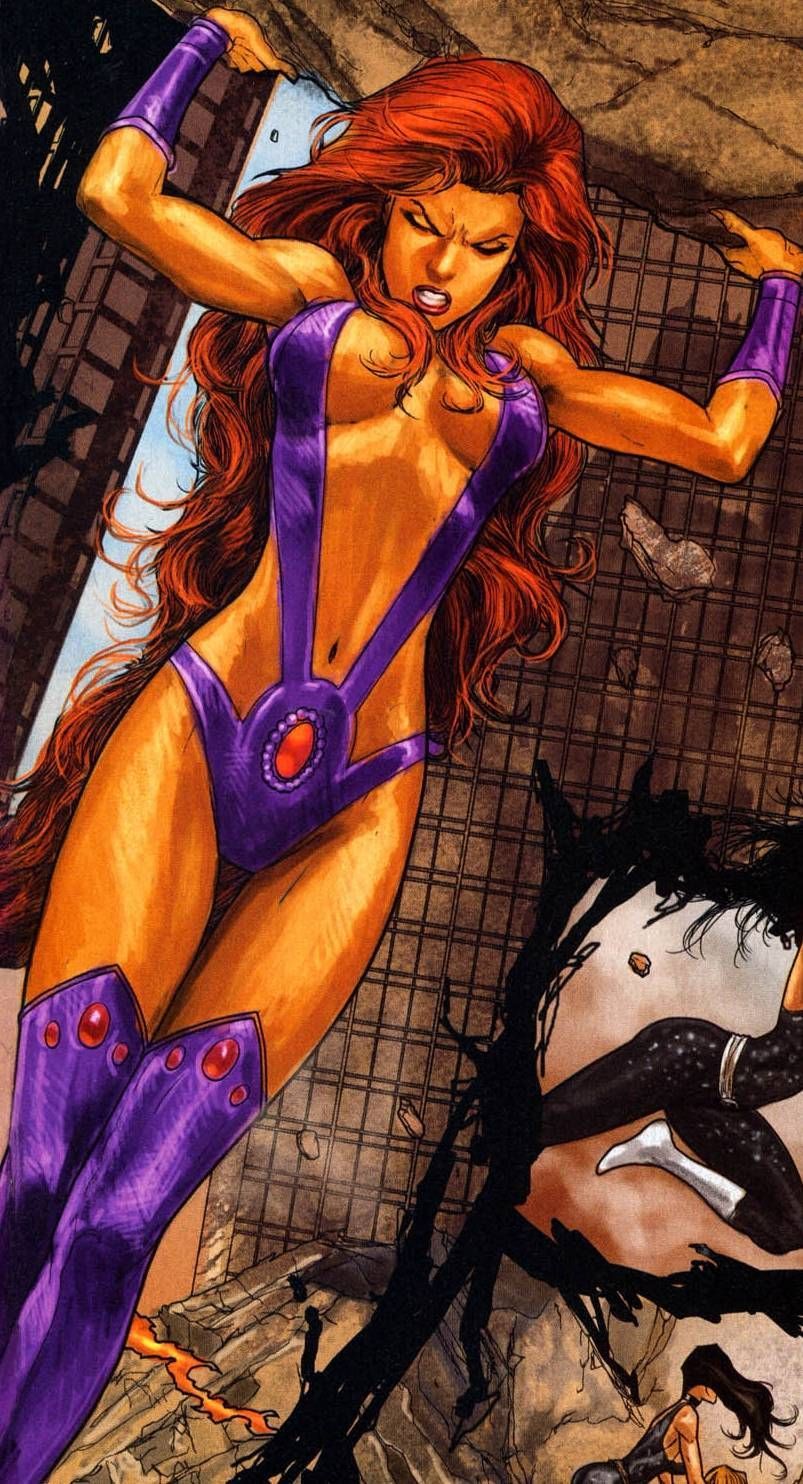
The female superheroes stand seemingly separate from the male superheroes, but men are still the part of the equation. Damsels, seductresses and knockoffs are directly linked to the male superheroes in forms of extensions of the mythos. The female superheroes exist in a state of eternal struggle against the male superheroes, male villains and male readers. According to O’Reilly, the female superheroes are restricted not only by the authorities, but even by their own sex (O’Reilly, 2012).
To understand the mechanism of gender politics within the comics, let’s examine Wonder Woman against the male superheroes, namely Superman and Batman. While deconstructing their dualistic natures, we encounter a paradox of Otherness (Fretheim, 2017: 10-11). Every superhero has a secret identity. This duality attracts the reader, by making him or her identify through resemblance with the superhero’s disguise as the everyman or everywoman. The comic book promotes the idea of inclusivity, participation. It indulges the fantasy, providing the impression of the activist participation. (Pitkethly, 2012: 216) Superhero defeats the villain and saves America, and the reader feels like he or she has contributed to the victory of ‘truth, justice and the American Way’. It is no coincidence that the popularity of superhero comics correlates to the periods of the high and low threat (Peterson, Gerstein, 2005: 887). In times of the high threat, such as the Second World War, there is a significant increase in interest for ‘powerful’ and ‘tough’ fictional protagonists (889).
Superman is also a meek reporter Clark Kent. Bruce Wayne is also a caped crusader Batman. As a superhero, Wonder Woman, too, exists as a heroic person and an alter ego of an ordinary woman, Diana Prince. Her otherness is expressed through being an Amazon, a super-powered being and a half-goddess. However, as a woman, she is also forced into position of the Other to Superman and Batman (De Beauvoir, 1949). If you’re unfamiliar with De Beauvoir, she referred to the socially constructed concepts of women and femininity in her Second Sex, written a year after women got the right to vote in France. The standards of the so-called femininity were established by patriarchal society and every woman was obliged to live up to these standards. De Beauvoir described the cultural symbols and social pressures put on girls from the very young age. Girls were taught to be passive and submissive, she did not have a choice as she was defined by the male dominated world to be a mother, a grandmother, a housewife. Men were the one, the neutral, the common, while women were the Other. While a man was the creator and the subject, a woman was an object in his power and always secondary to him. She also talked about the social taboos such as menstruation, criticizing pseudo-science that invented the idea of the biological inferiority of women. Menstruation was not the topic to talk about in public, since the very ancient times girls and women were locked in their houses during the periods. The female body is regarded as the Strange, Different, the Other. There is a cult of appearance; the women learn how to manipulate people with their looks. There are certain norms of how a real woman should look. The praises of female virginity and restrictions of the expose of the female sexuality were listed among the other ways in which the male society discriminated the female accumulation. Wonder Woman is, therefore, pitted as the Other to the male superheroes, while being alienated from other women.
So we can see that no category of the female characters in comics are any better than another or have it any easier than another. Nonetheless, the figure of the female superhero is important, because it is a definite step away and open resistance to being background or second-hand. Girls couldn’t relate much to Lois, because, honestly, they were not supposed to – she was not their fantasy, she was male fantasy. There were some female superheroes prior to Wonder Woman, but yet again, they were created by men for men, and girls didn’t want anything to do with them. Industry naturally assumed that the reason is girls being generally uninterested in comics. As Dr. Marston noted, ‘not even girls want to be girls’ (Lepore, 2016: 187). He set to change that, and hence Wonder Woman was born.
*it needs another note: Injustice series is actually one of my favourite comic runs ever, and it has great female characters and great character development and is simply amazing. But it’s based of a game, and they had to work with the game premise, and they did a fantastic job doing it. Still, as I love it dearly, I’m allowed to critique it and so I will.
**despite the name, Superman’s Girlfriend Lois Lane is a wild and fun comic.
Bibliography
Simone, G. (1999). Women in Refrigerators, available at: http://www.lby3.com/wir/
Austin, S. (2015). Batman's female foes: The gender war in Gotham City. Journal of Popular Culture, 48(2), 285-295.
Mulvey, L. 1999. ‘Visual Pleasure and Narrative Cinema.’ In Film Theory and Criticism: Introductory Readings, edited by Leo Braudy and Marshall Cohen, 833–44. New York: Oxford University Press.
Scott, S. (2013). Fangirls in refrigerators: The politics of (in)visibility in comic book culture. Transformative Works and Cultures, vol. 13
Fretheim, I. M. (2017) Fantastic Feminism: Female Characters in Superhero Comic Books. Trykk: Reprosentralen, Universitetet i Oslo
Cocca, C. (2014). Negotiating the Third Wave of Feminism in "Wonder Woman". PS: Political Science and Politics, 47(1), 98-103.
Cocca, C. (2016). Superwomen: gender, power, and representation.
O’Reilly, J. D. (2005). The Wonder Woman Precedent: Female (Super)Heroism On
Trial. Journal of American Culture 28.3: 273–83.
De Beauvoir, S. (1949). The Second Sex. New York: Vintage Books
Pitkethly, C. (2011). The pursuit of identity in the face of paradox: Indeterminacy, structure and repetition in Superman, Batman and Wonder Woman. Journal of Graphic Novels and Comics, 1-7.
Peterson, B., & Gerstein, E. (2005). Fighting and Flying: Archival Analysis of Threat, Authoritarianism, and the North American Comic Book. Political Psychology, 26(6), 887-904.
Lepore, Jill. (2015). The Secret History of Wonder Woman. New York: Knopf.
8 notes
·
View notes
Text
Batman Starter Pack
I’ve been through this routine once before (including the preface that I recognize there are a million other lists exactly like this on every comics-related site out there) but after having shared some starting points for Superman on Miracle Monday, I figure my second-favorite guy with his own personalized set of crime-fighting pajamas merits the same treatment on his own special day.
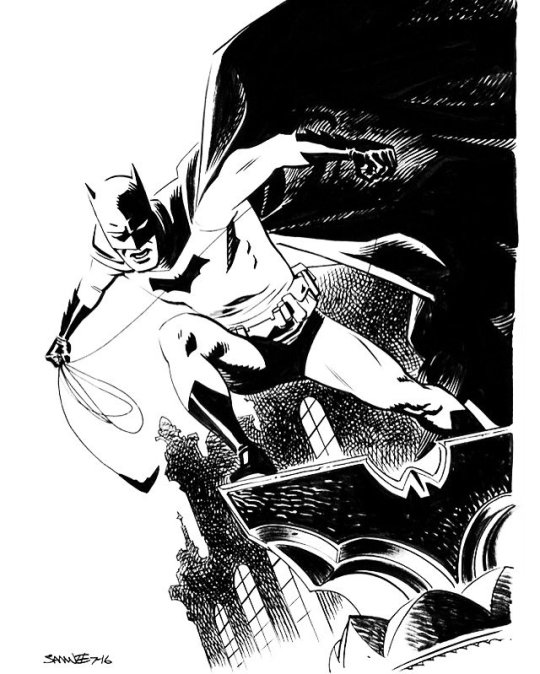
Assuming you’re forgoing a more traditional celebration of DC’s Batman Day - either having your parents brutally shot to death in front of your terrified, uncomprehending young eyes, or finishing your criminology degree and engaging in anonymous back-alley karate fights with circus clowns in response to the same - looking into some solid starting points for the character is a respectable alternative. Especially given some of his most classic adventures have recently come under some degree of critical reevaluation, while the likes of The Lego Batman Movie, the much-missed Batman: The Brave and the Bold, and the resurgence of the 1960s Batman TV show alongside contemporary developments in the comics have done a great deal to change the general perception of the character. So once again, here’s ten stories in a recommended - but by no means strict - order that should, as a whole, give you a pretty decent idea of what Batman’s deal is and why you should care, all of which you should be able to find pretty easily on Comixology or a local bookstore/comic book shop.
1. Batman: Zero Year
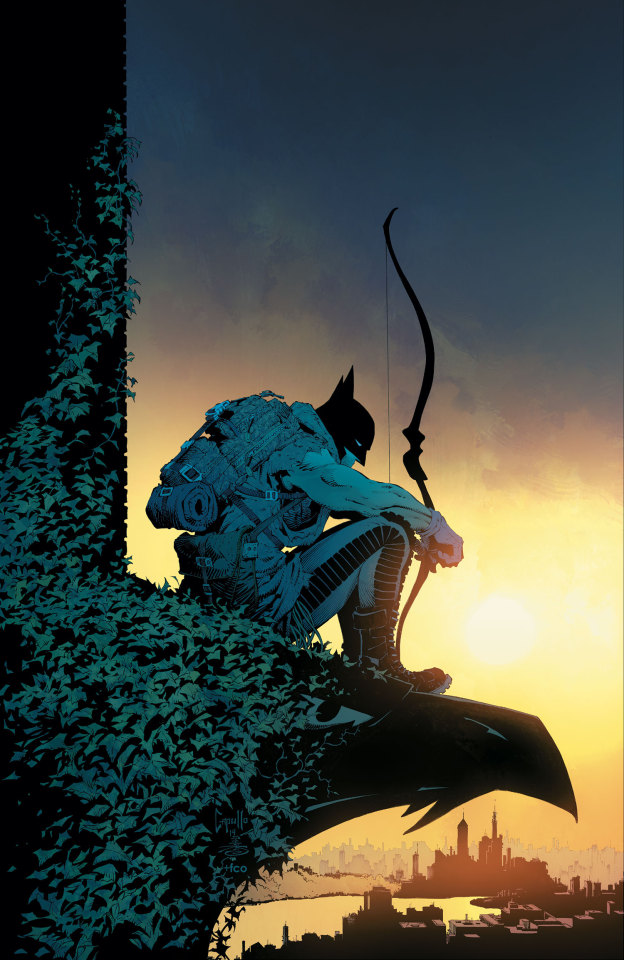
What it’s about: The current ‘canon’ take on his origin, it’s a pretty straightforward take on Bruce Wayne’s return to Gotham, early forays into crimefighting against the Red Hood Gang, and assumption of his familiar mantle...until the Riddler, a city-wrecking superstorm, and a literal bone monster get involved, culminating in a final act that has a sleeveless, dirtbike-riding Batman trying to save a post-apocalyptic Gotham whose citizens have become hopeless slaves of Edward Nygma’s merciless totalitarian riddle kingdom.
Why you should read it: This comic is bonkers, in absolutely the best way. Writer Scott Snyder has repeatedly said that since the previous major take on Batman’s origin in Year One was so iconic - to the point that, unlike Superman’s regularly refreshed history, it remained solidly in continuity for 25 years - no attempt at hitting the reset button could feasibly follow in its footsteps, and so the only way to make it work was to go as far in the opposite direction as possible, hence Dirtbike Batman and a Gotham of neon pink skies. And for all that, it works remarkably: it’s perhaps the least subtle Batman comic of all time, but it’s a solid look into what drives him, why he does what he does in the way he does it, and the beginnings of his relationships with some of his closest friends and enemies in the context of a mad, blockbuster story ranging from scraps with cops and gangsters to a race against time to literally save a city from death by fire. It is in many ways perhaps the most proudly and bluntly Batmaney Batman story of all time, the core of his world as screamed through a megaphone.
Further recommendations if you liked it: While maybe the most iconic work from their time together, Scott Snyder and Greg Capullo worked together on the main Batman title for 5 years and almost 50 issues, in arguably the most acclaimed run of Batman comics of the 21st century; I’d primarily suggest checking out Court of Owls, their first and for me best collaboration, but their entire tenure is worth your time, collected across 10 volumes. If you specifically want to indulge the off-kilter “wait, Batman’s doing what?” sensibility of Zero Year further, after his time on Batman proper Snyder wrote All-Star Batman, working with a number of iconic artists on some of his weirdest Batman comics; his later The Batman Who Laughs operates in much the same mode. If you’re mainly interested in the sort of Big Batman Event Story this and Court of Owls wrote the modern template for, Steve Orlando and companies’ Night of the Monster Men is maybe the most thoroughly entertaining example. And as a respectable recap of Batman’s life since his origins, while many longtime fans are ambivalent at best on it, Batman: Hush is an effective sampler platter of Batman’s history and relationships that’s proven enduringly popular among new readers.
2. Gotham Central
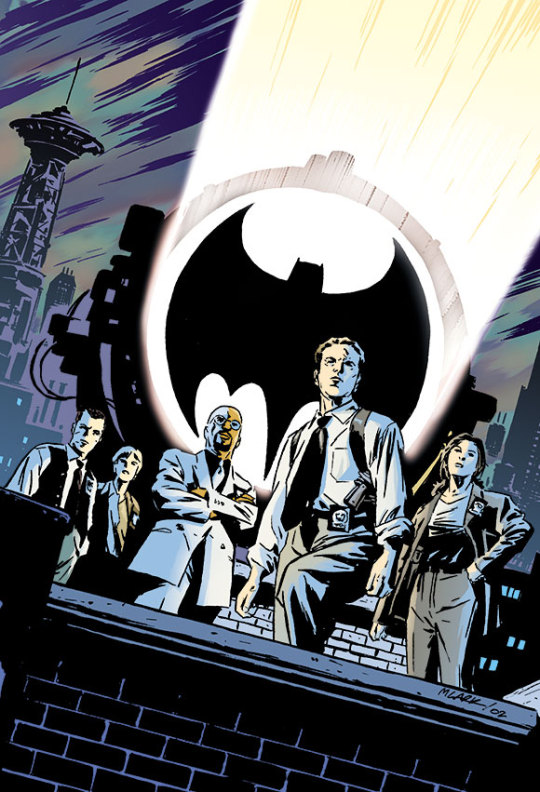
What: Set from the perspective of the grunts of the GCPD, Gotham Central shows what it means to be a cop in a city where you’re a pawn of the Bat at best, corrupt or a casualty if you’re not so lucky.
Why: Certainly the most acclaimed Batman-related ongoing ever published, there’s no book that better sells the ‘street level’ take on his world that so many want; Batman himself is largely a background presence, feared and resented by our actual leads as they go up against the incidental fallout of Gotham’s particular brand of horror. And all that’s before you even get to the Joker story that directly inspired The Dark Knight. While Gotham’s more traditional heroes may rarely show up, there’s no story that better explains why they’re needed, and what it means to live in their wake. And it’s Ed Brubaker and Greg Rucka and Michael Lark doing a cop book, so even Batman aside it’s worth your money ten times over.
Recommendations: Gotham Central may be a cop comic, but the cities’ most iconic officer in Commissioner Gordon only makes one or two appearances since he had retired at the time (an obviously temporary condition). If you really want to see him in action, you’re looking for Batman: Year One. Typically cited as one of the all-time great Batman stories - and it absolutely has some of his definitive moments and iconography - at heart it’s Lieutenant Jim Gordon’s year of figuring out how to make it in Gotham without losing his soul in the process, and it was that infusion of grim crime noir into the world of Gotham that defined the aesthetic Gotham Central operates under. If you’d like to pursue that particular line further, Batman: Turning Points is also worth hunting down, showing Batman and Gordon’s relationship develop over the years in reference to major upheavals in Batman’s world, and Batman: The Black Mirror, operating under a similar tone and showing Dick Grayson working with Gordon during the former’s own time in the cape and cowl, in a mystery connecting to both Batman: Year One and my next recommendation. Additionally, Kurt Busiek and John Paul Leon’s Batman: Creature of the Night provides an entirely different and disturbing type of ‘street-level’, ‘realistic’ view of Batman.
3. Batman: The Dark Knight Returns
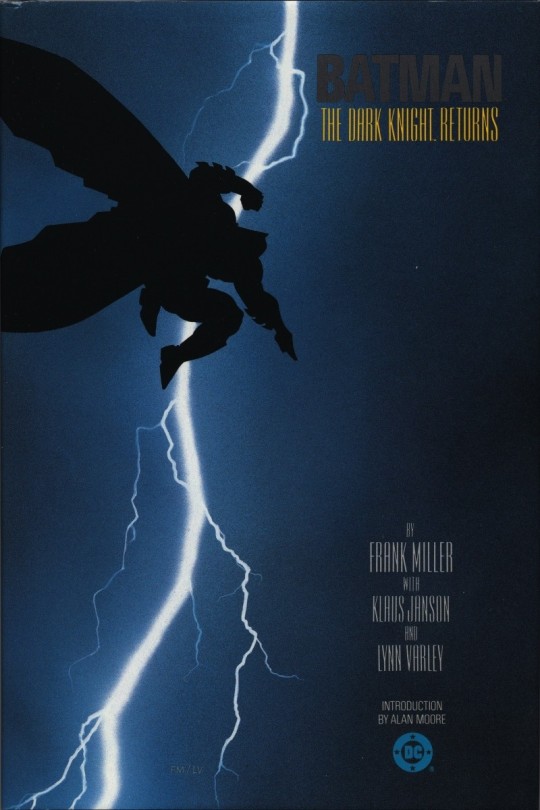
What: A decade after his retirement, an unprecedented Gotham crime wave forces a middle-aged Bruce Wayne out of retirement as he proves unable to resist the call of his demons. But even as he fights back the Mutant gang and recruits a new Robin, his resurgence has caught the attention of familiar enemies, and the political shockwaves of his vigilantism will ultimately bring him face-to-face with his oldest ally in a fight he simply can’t win.
Why: Commonly held up alongside Watchmen, which is a...touch of an overstatement in hindsight, while aspects of its politics and portrayal of the Dark Knight in question have aged somewhat questionably it’s regardless a justified classic by a one-time master of the medium at the top of his form, packed from top to bottom with brilliant storytelling, jaw-dropping moments, and a redefinition of the character that not only shapes him to this day, but the superhero genre as a whole. Definitely and very reasonably not for everyone, but essential to Batman as he exists today.
Recommendations: Frank Miller’s presented numerous followups to The Dark Knight Returns, and while The Dark Knight Strikes Back and All-Star Batman & Robin The Boy Wonder are hardly lacking in lively experimental flavor or gonzo charm, they’re an acquired taste at best: if you want to see more of this version of Batman’s world, you’re safest going for The Dark Knight Returns: The Last Crusade, a one-shot portraying the events leading up to Batman’s retirement a decade before DKR. For other seminal Batman stories that either don’t quite live up to the hype or have aged questionably but are all-in-all still probably worth looking into, check Arkham Asylum: A Serious House On Serious Earth, Batman: The Long Halloween (followed up by Batman: Dark Victory) and possibly The Killing Joke.
4. Batman: Ego and other Tails
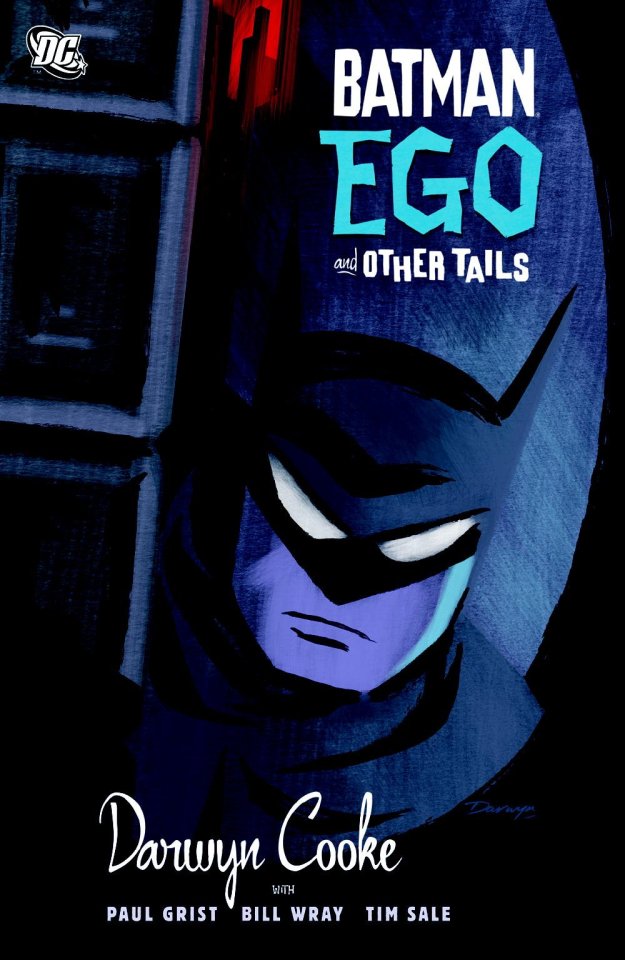
What: Before he was widely lauded for DC: The New Frontier, Darwyn Cooke was a storyboard artist for what we now know as the DCAU family of cartoons; his pitch for the job included a 14-page Batman story that years later would be edited and expanded upon to become Batman: Ego, where a catastrophic series of events leads Bruce to consider leaving his mission behind, forcing him to confront his demons more literally than ever before.
Why: Stories that question Batman’s sanity and his place in the world are a dime a dozen, but none like this, probably the deepest individual dive of all time into what exactly makes Batman tick. To say much more would spoil the amazing central conceit, but from his moral code to what he does or doesn’t give up by forgoing his life as Bruce Wayne, there are few aspects of his world this doesn’t touch on one way or another. Plus, while Ego may be the lead, the modern collection is stuffed full of other excellent Batman comics Darwyn Cooke had a hand in one way or another.
Recommendations: Most significantly, the collection also contains Selina’s Big Score, a Catwoman heist comic that leads into Ed Brubaker’s seminal run on the character, which are spread out over three trades that are absolutely worth picking up. If you’re interested in another story in the DCAU style and tone that goes into darker territory than the cartoons would typically dare, try Mad Love, the definitive Harley Quinn story. And if you want another headtrippy Batman comic that delves into his psychology, you’re looking for Death and the Maidens, intended at the time to be Batman’s final confrontation with Ra’s Al Ghul and featuring a conversation 65 years in the making.
5. Matt Wagner’s Dark Moon Rising titles
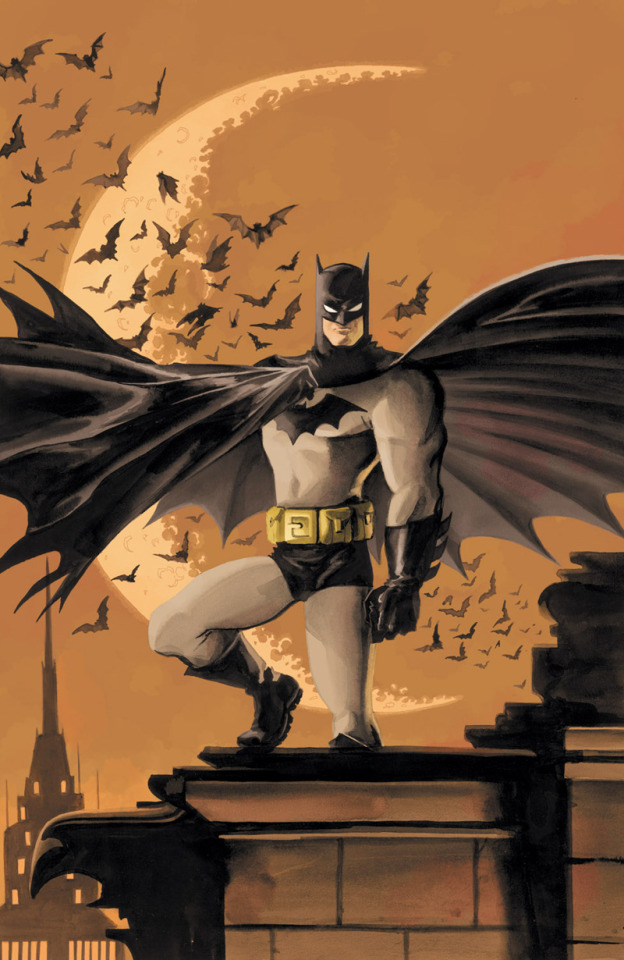
What: Eventually branded under the title of Dark Moon Rising, this series is actually made up of two six-part tales: Batman and the Monster Men and Batman and the Mad Monk, each Matt Wagner’s retelling of a classic Golden Age Batman story, from an era where the supernatural was not quite so distanced from Batman’s usual world.
Why: On a simple level, these are just some real good Batman comics; Matt Wagner’s a phenomenal fit for the character, these are nice and standalone, and Batman has to escape some deathtraps, which is always a treat. But the introduction of the truly bizarre to Batman’s world - by a standard that allows for coin-flipping disfigured District Attorneys and maladjusted widowers with freeze-rays as all part of the regular scenery, anyway - can be something of a hurdle, especially for new readers. In that regard this is a perfect introduction to the more outré side of Batman’s job, cushioning the transition with wild pulp adventure and thrilling horror in a series that feels entirely of the same world seen in the likes of Year One, even as Batman fights a vampire who is also a werewolf.
Recommendations: If you enjoyed the look at a Batman who’s still somewhat figuring out his limits and the parameters of his operation, you’re in luck, as Year One-era Batman stories formed their own effective subgenre for the character for awhile, primarily in the series Legends of the Dark Knight, which had one of the better hit-to-miss ratios for Batman ongoing titles, and Batman: The Man Who Laughs, Ed Brubaker and Doug Mahnke’s take on his first encounter with the Clown Prince of Crime. If the pulpy noir approach is what appealed, I’d say you might be in the market for Batman: Strange Apparitions, the collection of Steve Englehart and Marshall Rogers’ highly influential 1977-1978 tenure on Detective Comics (plus a preceding couple issues by Englehart drawn by Walter Simonson, and a couple issues by Rogers without Englehart), a major step on the road to Batman as he exists today which also featured the - at the time - unexpected return of one of the Golden Age villains Wagner features.
6. Nightwing: Better Than Batman
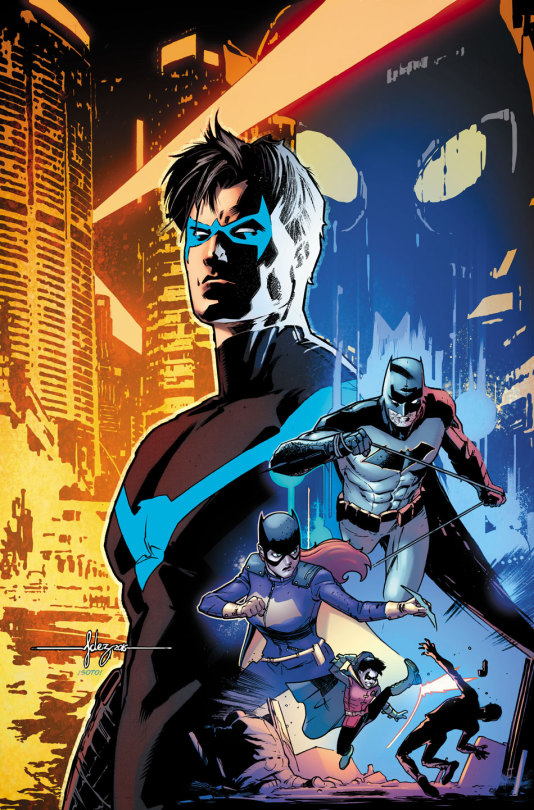
What: Under the thumb of the Parliament of Owls, the Courts’ international equivalent - if with more up his sleeve than they expect - Nightwing finds himself in deeper than he ever could have imagined as he falls under the ‘mentorship’ of the mercenary Raptor, who not only leaves Dick questioning lessons he had previously taken as gospel, but tumbling down a rabbit hole through his own past that threatens to destroy the life he’s built for himself in the present.
Why: There’s no comprehensive look at Batman that doesn’t involve the family he’s built for himself, and this in my mind is the definitive story of the original Robin. Touching on his heritage, his early days as the Boy Wonder, his modern MO as a dashing international superhero with a pinch of espionage, and his connections with the rest of his crime-fighting family, the heart of the story is his relationship with Bruce: their days as Batman and Robin, their differing methods and ideologies, the complications stemming from their distinct backgrounds, and how their brotherhood ultimately saved them both. More than any other single book it underlines the foundation of what makes Dick Grayson work, and by extension the entire concept of the Batman Family.
Recommendations: Better Than Batman is the most compact and satisfying example of what defines Robin and the Batman Family as a whole, but if you’d prefer something more expansive in scope, Batman and Robin Eternal touches on many of the some ideas. For both a solid look back at Dick’s career back when wearing pixie boots, as well as the origin of one of the other two major templates for Batman’s sidekicks, Robin/Batgirl: Year One collects a pair of cult classic stories, Batgirl in particular being the one to check out. As for the third, while Jason Todd’s most iconic story is unquestionably Death in the Family, its actual quality hardly lives up to its enduring imagery and impact; you’ll be best served looking at his return from the grave in Batman: Under The Hood. Alfred’s the other major foundation of the family, and for him I’d probably recommend the soon-to-conclude All-Star Batman arc The First Ally. As for the rest of the family, for hitting the most members in one package I’d recommend James Tynion IV’s run on Detective Comics - beginning with the trade Rise of the Batmen - which returns or recontextualizes a number of fan-favorite characters under an umbrella of incredibly solid Batman Family adventure stories.
7. Paul Dini’s Detective Comics
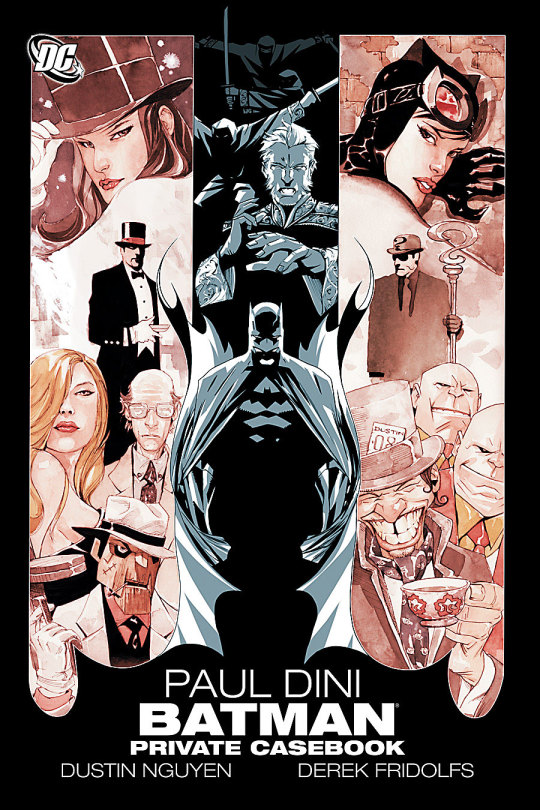
What: Collected across Batman: Detective, Batman: Death and the City, Batman: Private Casebook, and Batman: Heart of Hush, Paul Dini - one of the main architects of Batman: The Animated Series, and much of the later DCAU as well - serves up a run of almost uniformly excellent, largely done-in-one Batman adventure stories.
Why: Iconic storylines may draw attention to a character, but the brick and mortar of the greats is laid on a foundation of just plain good comics, month-in and month-out, and there are few better examples for Batman than with Dini’s tenure on Detective Comics, especially with the likes of J.H. Williams, Don Kramer and Dustin Nguyen in tow. They may not be stories that redefined the character for a new generation, but they’re simply and unassailably Quality Comics of a sort rarely achieved.
Recommendations: For a more old-school example of the same principle, Denny O’Neil and Neal Adams’ classic tenure on the character is as good as it gets, featuring the likes of The Joker’s Five-Way Revenge - the first comic since his earliest appearances in the 1940s to portray him as the killer clown we know today - and the first appearance of Ra’s Al Ghul. The multiple spinoff comics of Batman: The Animated Series such as the multiple iterations of Batman Adventures and Batman: Gotham Adventures also have a solid hit-to-miss ratio in that regard. And if you’re interested in more of Paul Dini’s Batman comics, Batman: City of Crime with Alex Ross is one of the characters’ all-time great stories, and Dark Night: A True Batman Story with Eduardo Risso is a powerful autobiographical piece on how Dini’s life and work collided in his darkest hour.
8. The Greatest Batman Stories Ever Told
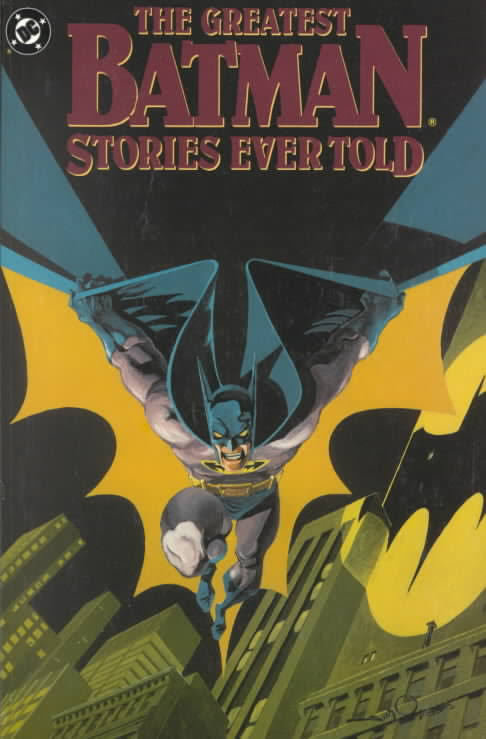
What: Exactly what it sounds like, this trade collects standout Batman stories from across the first 50 years of his history.
Why: The trouble with comics is that not all of a characters’ best material is necessarily in individual trades, or single runs - just stick to those and you’ll miss out on some stone-cold classics. There have been plenty of collections attempting to gather up the ‘best of the rest’ to rectify that though, and of those I’d particularly recommend the edition above, filled from top-to-bottom with not only delightful artifacts like The Batman Nobody Knows! and A Caper a Day Keeps the Batman at Bay!, but definitive stories such as The Autobiography of Bruce Wayne! and Death Strikes at Midnight and Three.
Recommendations: For a similarly charming - though I believe far more difficult to track down - retrospective, Batman from the 30′s to the 70′s is certainly worth picking up if you ever happen to see it around. If you find older Batman stories appeal, it’s worth checking out both The Batman Chronicles, collecting his earliest appearances in the 30s and 40s, as well as Showcase Presents: Batman with his 60s adventures, and perhaps the more recent run Batman ‘66, a direct continuation of the Adam West/Burt Ward TV series. You might also be interested in The Brave and the Bold #200, featuring a 'teamup' of sorts between the Batmen of two eras. If what mainly appeals to you is the thrill and comic value of seeing Batman in bizarre situations you’d never see now, Showcase Presents: The Brave and the Bold might be your speed, containing Bob Haney and Jim Aparo’s madcap tenure, as well as Neal Adams’ relatively recent lunatic masterpiece Batman: Odyssey.
9. Planetary/Batman: Night on Earth
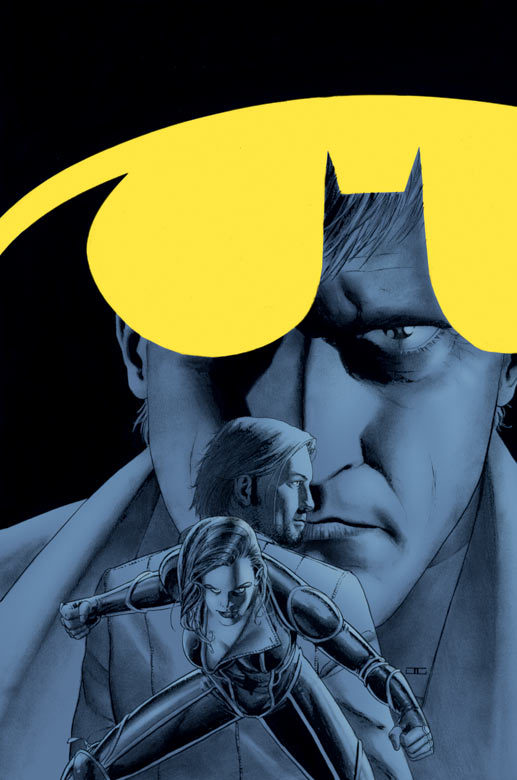
EDIT: This list was written prior to allegations made against Warren Ellis. It’s your money, but while I’d still recommend checking the book out of the library - the quality of the work isn’t going to change now that it’s out there in the universe - if you’re looking to pad your bookshelf I might recommend skipping to some of the books suggested below in its place.
What: “Mystery archaeologists” Jakita Wagner, Elijah Snow and The Drummer are a group of superhumans investigating beneath the skin of the Wildstorm universe to uncover the wonders and terrors lurking in its darkest corners. On a trip to Gotham City to apprehend serial killer John Black, his own abilities trigger when cornered to rotate them all through different realities...and in other versions of Gotham, they find they’re not the only ones looking to bring Black to justice.
Why: Planetary built itself on distilling artifacts of 19th and 20th century pop culture (typically by proxy) down to their most essential ideas and iconic values as mysteries to be unveiled, whether 1920s pulp heroes, Godzilla, Sherlock Holmes, 80s and 90s Vertigo comics, James Bond, John Woo revenge flicks, or any of a dozen others. While the other two Planetary crossovers break with formula, this applies it to the biggest modern 20th century icon of all, as a group of hardened Warren Ellis-y superbeings entirely unfamiliar with the concept of ‘Batman’ are forced to run a gauntlet of over 60 years of his most iconic takes when their versions of justice collide. As far as I can tell regarded as a footnote in Batman’s own history, it’s regardless one of his all-time greatest stories, extrapolating him in every direction at once to find the core that unites them all, topping it off with the no-shit best Batman moment of all time.
Recommendations: Most obviously, soon as of the time of this writing Warren Ellis will be tackling a full-scale Batman project alongside longtime collaborator Bryan Hitch, The Batman’s Grave, which I couldn’t be more excited for and obviously recommend checking out. For other stories taking a particularly off-kilter look at Batman and his world, whether through unusual styles or with versions of the character entirely unlike anything ever known, you’ll want to check out the trades of Batman: Black and White, an anthology running as a backup through numerous Batman titles eventually collected in trade, showing a gauntlet of top creators doing their own brief takes on Batman and his world, kicking off no less with another Ellis-written Batman story that powerfully sums up his drive. If you’re looking for something more specifically in the vein of Night on Earth though - a stripped-down, iconic Batman that acknowledges the odder parts of his history and confronts deep emotional truths about himself amidst high-action spectacle - then the current run on Batman proper by Tom King and company is something I’d certainly recommend checking out on the understanding it comes with ups and downs.
10. Batman: The Black Glove
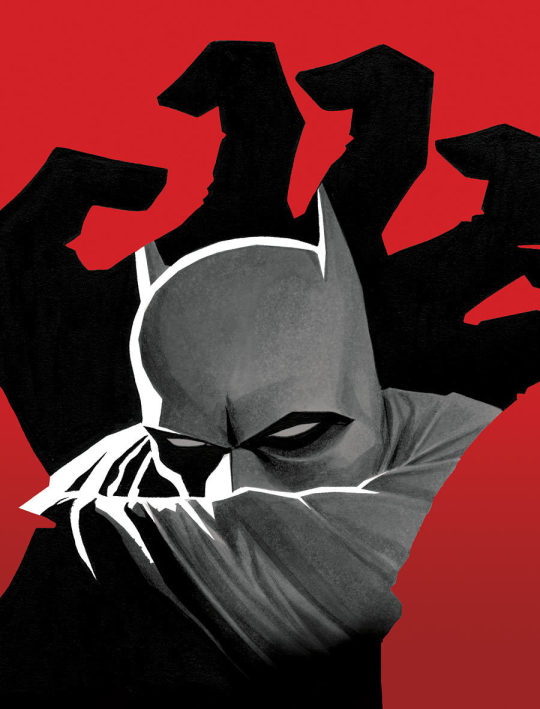
What: From his great lost love to family he’s never known, from the basement of the GCPD to the bowls of Arkham, from the secrets of the past to the horrors of the future, from the ends of the Earth to the inside of his mind, the grip of Batman’s greatest enemy reaches wherever his shadow falls. Collected variously as Batman and Son and Batman: The Black Glove, Bruce Wayne finds himself matched against a seemingly disconnected series of challenges ultimately pointing towards the machinations of a greater threat; one that has constructed his downfall across decades, weaponizing his own mind and history against him as they build towards breaking the Batman once and for all.
Why: These issues are the start of the best Batman comics of all time. They’re absolutely fantastic all on their own, make no mistake; the first arc introduces one of the most significant Bat-family characters of all time, The Clown At Midnight is a criminally underrated classic, and Club of Heroes has J.H. Williams III drawing what amounts to 7 Batmen and 3 Robins being trapped in the plot of And Then There Were None. But more than that, these issues lay the foundation of a 7-year run by Grant Morrison built around mysteries that reach across every facet of Batman’s world, which not only reinvents him as a character, but is frankly and simply the best sustained run on a major superhero of all time. This should by no means be the first Batman comic you ever read, but make no mistake: everything leads to this.
Recommendations: Well, for one thing there’s the rest of the run. Before moving on, you may if possible want to check out Batman: The Black Casebook, a collection of numerous Golden and Silver Age comics that Morrison drew on significant plot and thematic elements of for his work, and Dark Knight Dark City, a supernatural thriller and one of the best Batman-as-detective comics out there which ends up forming much of the spine of some of Morrison’s biggest developments. From there, the rest of his run is collected across Batman R.I.P. > Batman and Robin: Batman Reborn > Time and the Batman > Batman vs. Robin > Return of Bruce Wayne > Batman and Robin Must Die! > Batman Incorporated > Batman Incorporated: Demon Star > Batman Incorporated: Gotham’s Most Wanted.
While much of the impact of the run was immediately dismantled (in large part by Morrison himself, who’s had similar experiences in the past and wanted to show the ideas he introduced off on his own terms here), slowly but surely creators are coming around to what he was doing and have followed up accordingly. Grayson - one of the most beloved DC titles of the last several years - follows the original Robin as he infiltrates the superspy agency Spyral introduced in Batman Incorporated, and leads directly into the previously mentioned current excellent run on Nightwing, which itself has a direct sequel to Morrison’s Bat-tenure in the arc Nightwing Must Die! The major DC event book Dark Nights: Metal by the team behind Batman: Zero Year is itself a direct sequel to several of Morrison’s biggest DC stories, his Batman run most of all. Morrison himself at one point announced plans for Arkham Asylum 2, which rather than following up on his graphic novel Arkham Asylum: A Serious House On Serious Earth is apparently a direct sequel to his Batman epic starring Damian Wayne as the Dark Knight; hopefully it will one day see fruition. Finally, if you’re simply looking for something on a similar wavelength of bizarre, lurid international pulp mystery mixed with wild fist-pumping superhero action and character moments, the ongoing crossover Batman/The Shadow - soon to end and be directly followed-up by The Shadow/Batman with the same writer - is easily one of the best of its kind of cross-company team up and absolutely a descendant of the type of Batman comics Morrison’s tenure produced.
140 notes
·
View notes
Note
Hi! I'm really interested in reading comics/graphic novels about or featuring the Batkids, and you seem like you know about that kind of thing (or at least more than I do, although it's a low bar), so do you think you could give me some suggestions to get started with? Also, I've seen some DC stuff at the library with "Death of the Family" on it but some is Batman and some is Batgirl and I think I saw a Teen Titans one and are they all connected or something? I'm confused. Thanks!
Yes! I do know quite a bit about comicsin the BatFam area, I just unfortunately can’t recommend anythingthat came out in the last 2 years as I’ve not read it. But 1989-2015I can give LOTS of recommendations.
For the most part any title can be astandalone, but titles do unfortunately get wrapped up in companywide events at times. But if you read the GN rather than theindividual comics they try and keep events to their own combo storybooks and character titles to their own.
This is such a huge list that I’mputting it under the cut so you click to read it instead of everyonegetting spammed with a HUGE list of things…
Here is what I’d recommend:
-Jason Todd as Robin II (Later known asRed Hood): It seems as though the majority of Jason writers presentday neglected to actually read his original issues, because they basetheir knowledge and opinion of him on what readers in the 80’sTHOUGHT of him, and unfortunately at the time many people hatedJason. Much of the hate was for a Robin in general as at the timeplenty of people thought Bruce should be on his own. No Batgirl (seethe Killing Joke) and no Robin. So the hate was for the role ingeneral. And then you had Robin fans that hated him just because theydidn’t want anyone trying to replace Dick’s role even though Dick hadmoved on to Nightwing. Jason as Robin issues are Batman #408-428, andNew Teen Titans Vol2 #19-21, 24, 28-31. I’m sure there were issues ofDetective Comics, but I have no idea which. In recent years much ofthese issues are in GNs but some of the issues are not, so you mayhave to look those up individually to read online or buy them instores with older issues. These GN are- Batman: Second Chances(Batman Issues #402-403, 408-416, and Annual #11), Batman Ten NightsOf The Beast (Batman Issues #417-420), DC Comics Classics Library:Batman- A Death In The Family, Hard Cover (Batman Issues #426-429,440-442, New Teen Titans Vol2 #60-61). this edition of “A Death InThe Family” contains both the death of Jason and the introductionof Tim, which was a story focused around Jason. So it’s a 2-for-1deal. There’s also a GN called Batman: The Cult and Jason’s the Robinwith Bruce in that story as well though I’m not sure where to placethat in the chronology.
-Tim as Robin III (Later known as RedRobin): Tim had an excellent run as Robin. He had 3 mini-seriesbefore he had an entire run of his own that spanned 183 main issues,not counting team ups or annuals. All while also appearing in theother Batman, Nightwing, and Batgirl titles. Plenty of issues werecompany wide tie-in issues but the rest were all put into their ownGNs. Robin: A Hero Reborn (Batman #455-457, Robin Mini-series1 #1-5),Robin: Tragedy & Triumph (Detective Comics #618-621, RobinMini-series2 #1-4), Robin Mini-series3: Cry Of the Huntress #1-6 isnot in a GN that I know of, then the rest of his main run in FlyingSolo, Unmasked!, Fresh Blood, To Kill a Bird, Days of Fire andMadness, The Virtual Cell, Wanted, Teenage Wasteland, The BigLeagues, Violent Tendencies, and Search for a Hero.
Likewise…
-Dick as Nightwing in his solo title(Vol2): 153 issues not counting team ups or annuals. Like with Robinmany of these issues are tied in with company wide events, and therest are in their own GNs. I recommend the 2014-present editions asthey have a bit more in them, better paper/graphics, and are wayeasier to find, but they haven’t remade all of them yet. Nightwing:Blüdhaven, Nightwing: Rough Justice, Nightwing: False Starts,Nightwing: Love and Bullets, Nightwing: The Hunt For Oracle are thenew editions. Continuing from there the older editions are:Nightwing: Big Guns, Nightwing: On the Razor’s Edge, Nightwing: YearOne, Nightwing: Mobbed Up, Nightwing: Renegade, Nightwing: Brothersin Blood, Nightwing: Love and War, Nightwing: The Lost Year,Nightwing: Freefall.
-Batman Knightfall: One of the classicBatman stories, in which the main bad is the villain Bane, whoseriously injures Bruce. This story spans three GNs: Broken Bat, WhoRules The Night, and Knightsend
-Batman Cataclysm: Another classic. Amassive earthquake hits Gotham and decimates the city. This can befound in one GN, thought look for what I think is the 2012 edition ofthe book not the one one as they included a lot of previous cut storyin the newer edition.
-Batman No Man’s Land: FollowsCataclysm. Essentially Gotham is covered in rubble and a massiveterritory war breaks out between BatFam, GSPD, and several separategroups of Gotham’s baddies. It spans 4 super thick GNs in the 2012newer edition (don’t bother with the older editions) but also has areally enjoyable novelization if you would prefer to read it inwritten format!
-Batman Hush: Essentially Bruce vs Hushand sometimes Clayface, and a story that unintentionally set up JuddWinick to bring Jason back to life lol…one GN in more recenteditions but was previously 2 smaller GNs. I do not know if there isa difference but generally larger book versions have a bit extra inthem.
-Batman Under the Red Hood: Jasonreturns as the Red Hood, sending Bruce on an emotional rollercoaster, while Joker and Black Mask end up roped in. Lots of peopleinvolved. Like Hush this come in one or two book format. I have thesingle book format. This story was adapted into an animated movie,one that also takes a few moments from “A Death In The Family”,but the beginning part was highly modified to make it a stand alonefilm, so several key details are removed. I do recommend watching themovie, but after reading both “A Death In The Family” and thecomic version of “Under The Red Hood”, so you get the fullexperience.
-Batman War Crimes, War Drums, and WarGames (WG is three GNs long): this connects into both Robin and RedHood. This is unfortunately where Stephanie (Spoiler, brief Robin IV,Batgirl) “dies” and there’s a massive war against Black mask.It’s five GNs total.
I pretty much have to recommend anyBatman Titled GN that comes after that as it goes more into Hush,Damian comes in and there’s a lot of plot to cover there, Bruce“dies” and the mantle is picked up by Dick, and it was a heck ofride until the reboot happened.
Outside of main Batman titles aroundthat time I have to HIGHLY recommend the following:-Batmanand Robin: Basically Dick and Damian’s team-up book series. Itspanned three GN with Morrison, and one after him totaling four. Wealso got more Jason here, and his sorta Batgirl type sidekickSasha/Scarlet. Admittedly it was weird because Morrison thought itwould be fun to give Jason red hair (something the main version ofJason never had, but had in issues for another version of Jason thatwas scrapped before any issues I mentioned in this post) and bulk himup. But if you can gt around that the actual plot on the Jason endwasn’t too bad and had some gems. But the Dick and Damian interactionand banter is the treasure here.
-Batman Streets Of Gotham: Again moreof Dick and Damian as Batman and Robin. But here we get Thomas Elliot(Hush) who surgically had his face changed to look like Bruce, and hefill Bruce’s public role under very close watch. We also get Damian’slittle friend Colin Wilkes (Abuse) who ends up close to him. He turnsinto a giant bulky rage man good guy :)
-Red Robin: Tim’s new solo series thatstarted after Damian took up being Robin and Dick went from Nightwingto being Batman. It’s 4 GNs long and was amazing. I can’t stress thatenough. I still mourn it ending. You get Tim on his own, you get himgoing up against/working with/outsmarting/impressing Ra’s al Ghul.You get Prudence Wood, one of Ra’s assassins that ends up liking andworking with Tim. You get Tam Fox, and Stephanie, and Conner Kent.
-Batgirl Vol3 (Stephanie Brown asBatgirl): Stephanie came back from faking her death, took back upSpoiler, only for Tim to demand she stop being Spoiler. He shouldhave been more specific, and she DOES drop Spoiler but then becomesBatgirl with previous Batgirl’s (Casandra) blessing lol. Spanned 24issues in three GNs but they are hard to find. Obviously there isCasandra’s run as Batgirl but i’ve never actually read it so I findit wrong of me to suggest it before I have so it’s up to you if youwant to hunt those down as well. But Casandra’s run was 73 issuesVol-1 (7 GN) sand 6 issues Vol-2 (which is in a single GN)
-Teen Titans Vol3 (Tim, Conner, Bart,etc) spans twelve GNs and had its ups and downs, but if you’re a teamfan this is a good series to read.
-Catwoman: A few different runs, andsome stand alone books. They’re all good pre-reboot. Read them ifyou’re a Catwoman fan :)
Now as far as books NOT in the main runof pre-reboot comics I also REALLY need to recommend the following:
Batman Year One: Bruce’s first year asBatman. Also Gordon’s first year on the job. One GN. Awesome and alsoadapted into an animated movie.
-Robin Year One & Batgirl Year One:These come in separate books or both in one big book. The Robin inmention is Dick and the Batgirl is Barbara. Both are fantasticstories.
-Huntress Year One: Huntress’ originstory. This is the Huntress that is NOT Bruce’s daughter from anotherEarth, this is the Mob associated one that was also featured in theTV series Arrow.
Superboy / Robin World’s Finest Three:two tiny GNs that tell the story of Tim and Conner’s first meeting.They end up going against Metallo and Poison Ivy.
JLA: World Without Grown-ups: This is astory spanning again two tiny GNs. Where Tim (Robin), Conner(Superboy), and Bart (Impulse, later known as Kid Flash) team up whensuddenly all the adults are in one dimension and all the underagepeople are in another.
Red Hood: The Lost Days: the story ofwhat happened between Jason’s resurrection and when he came back toGotham in Under The Red Hood. It’s one GN.
There are also some alternate universe stories that came out pre-reboot called Elseworld’s stories. Here are some good ones:
Batman:Brotherhood of the Bat: Alternate Universe what-if type story. Thisstory is if Talia had joined Bruce in Gotham and abandoned her fatherRa’s and his ways. The story is centered around their son, TallantWayne. This was an AU created before Damian entered the comics andthus one of many stories where Bruce and Talia’s son had a differentname. Bruce is dead and Tallant has to face his grandfather. This wasone thin GN but did have a sequel…
Batman: League ofBatmen: takes place after the above and spans two GNs to finish thestory.
Thrillkiller Batgirl & Robin: 3 issue AU where Barbara and Dick are the first vigilantes in Gotham in the 1960′s and go up against a FEMALE Joker. Bruce is a legit Detective. Every bit of this story is PAINTED and it’s amazing. It is followed up by a sequel.
Thrillkiller ‘62: Takes place where the above left off. But now Bruce is Batman alongside ‘Batgirl’. I won’t spoil the events of the above to give goo detail here lol.
Superman: Speeding Bullets: AU where Baby Kal-El crashes into Earth, where he is discovered by Thomas and Martha Wayne. The couple decide to adopt Kal-El, and name him Bruce. Fuses the two characters together. Thomas and Martha still die. “Bruce” becomes a flying Batman and later Superman.Batman: The Dark Knight Returns: Pretty much the most popular and longest AU that DC did. Spans 1 thick GN or multiple tiny ones. Not the greatest of art/setup but still good. Think of this as an AU Future Fic taking place after Jason died and Bruce retired instead of Tim coming along. Then he comes out of retirement to be a total badass. I do NOT however recommend any of the sequels or prequels because they are just BAD. This was adapted into TWO animated films which I honestly think I recommend more than the GNs due to the art.Post Reboot we hit the New 52. It had its up and downs. Nothing BatFam was particularly terrible but very little was amazing. personally the first 4-6 volumes of GNs for any given series was worth a read but not necessarily a buy. I read all the BatFam titles and the only ones that were MEH for me were Catwoman and Teen Titans. Red Hood and the Outlaws wasn’t for everyone, but I personally enjoyed it other than some details like Jason suddenly having magic??? and Kori having some personality issues but I was glas she wasn’t ditzy if that makes sense, and I really loved her character design even if I wish she at least had a touch more clothing on (once she was in a space suit and it was amazing). Suicide Squad isn’t technically BatFam but it had Harley in it in the New 52 and it was amazing even if I hated her visual re-design. Talon was a branch off of a Batman story line, and a specific character got his own title that spanned 2 GNs and was enjoyable.
Past that any Gns involving Batman The Animated Series are great, so are the Young Justice GNs.
I also have a huge love for the Batman Beyond show and Comics, but after the reboot they messed that up too.
3 notes
·
View notes
Text
In the '90s, Batman was at its best in Mask of the Phantasm
Before Christopher Nolan’s trilogy, the only movie that took Batman seriously was a cartoon.
Originally a direct-to-video release, Warner Bros. Animation rushed “Batman: Mask of the Phantasm” into theaters 25 years ago next month. Created by the Emmy award-winning team behind “Batman: The Animated Series,” this feature-length animated film was thrown into theaters during the 1993 Christmas season alongside heavyweights like “Schindler’s List” and “Philadelphia.” Of course, “Mask of the Phantasm” flopped.
Even as Roger Ebert and Gene Siskel praised its 1994 home video release, “Mask of the Phantasm” existed as an overlooked stop-gap between Tim Burton and Joel Schumacher’s live action entries, 1992’s “Batman Returns” and 1995’s “Batman Forever.” However, “Mask of the Phantasm” did what Burton and Schumacher couldn’t—it gave us a reason to care about Batman. Until the ‘00s, “Mask of the Phantasm” was the only Batman movie that made Batman the subject of its film, not an accessory.
Directed by Eric Radomski and Bruce W. Timm from a story penned by “The Animated Series” vet Alan Burnett, “Mask of the Phantasm” shows The Dark Knight investigating another masked vigilante named the Phantasm. The new presence appears in a cloud of smoke, with a blade for a fist, attacking Gotham City mobsters. At the same time, Wayne’s old flame, Andrea Beaumont (voiced by Dana Delaney), has returned. Could she be the Phantasm?
Through film noir-style flashbacks, “Mask of the Phantasm” presents a vulnerable Bruce Wayne (voiced by Kevin Conroy) reckoning with his past while facing a violent future as Batman.
While other Batman movies flirt with Wayne’s haunted past, this is the main focus of “Mask of the Phantasm.” Not only did Wayne lose his parents at a young age, he also lost the love of his life, his only semblance of normalcy, in Beaumont. The audience is finally given displays of his anger, guilt and disappointment. In the midst of making another challenging decision, Wayne stares at his parents’ portrait in his manor, wondering if he’ll reconnect with Beaumont. In flashbacks, Wayne visits his parents’ grave, seeking advice about his love for Beaumont, and later asking permission to become Batman.
The movie also shows Wayne’s difficult transition into a superhero. A man who brazenly fights crime, be it in a ski mask or blue sweatshirt, becomes Batman. After these sequences, we see Wayne bloody, bandaged and bruised, which felt like a first at the time. Even after he has become the famed vigilante, Wayne perks himself atop a skyscraper as Batman. While in costume, Wayne is preoccupied with the past as he spies on Beaumont going on a date with councilman Arthur Reeves (voiced by Hart Bochner). The rain pours as Batman grimaces, focusing his binoculars on Reeves and Beaumont sharing a romantic moment. Those types of details were never delivered in live-action Batman movies until “Batman Begins.”
Unlike every live-action Batman movie, “Mask of the Phantasm” runs under 80 minutes. Rather than stretching out a movie over two hours, it excels as a lesson in tight storytelling. As Siskel noted in his review, “Every image counts.” Each scene moves the story along at a rapid pace. There are no lulls. Just as soon as the Phantasm is introduced, taking out crime boss Chuckie Sol, the film moves to Reeves yelling for Batman’s head, then Wayne hearing of Beaumont’s return.
Ebert added that “Mask of the Phantasm” worked well because “animation can do some things live-action can’t.” An obvious statement, but it’s spot-on and still applicable to modern day comic-book movies. Here, Wayne climbs the grill of an 18-wheeler and throws spiked bombs at its tires. The truck flips, creating an impressive sequence that countless action movies have duplicated with success and failure. Later, Wayne confronts a gang of punks, jumping towards one motorcycle-riding baddie and landing a punch. It’s an acrobatic stunt modern CGI still can’t replicate as naturally.
In contrast, Burton and Schumacher’s Batman movies are two-hour-long time capsules of each director’s style. “Batman” is dark, and then Jack Nicholson appears as The Joker, jamming some Prince. “Batman Returns” is full of Burton’s quirks (leather, prosthetics, an appearance by Paul Reubens) and not much else. Burton’s films are both more interested in their villains—Joker & Penguin/Catwoman—than the hero himself.
Schumacher’s aren’t really interested in anything at all. The director lit scenes with neon pinks, greens and blues, shot action at canted angles, and overstuffed his casts with big names playing meaningless parts (hello, Drew Barrymore, Debi Mazar, Alicia Silverstone, Vivica A. Fox and Elle Macpherson). Two decades later, even Schumacher admitted that “Batman & Robin” was a toy commercial.
In comparison, “Mask of the Phantasm” doesn’t feel like a product of the ‘90s. Instead, half of the movie feels like it’s set in the 1940s. The creators credited “Citizen Kane” as inspiration for the film’s flashbacks. You can find more examples of that classic feel in “Mask of the Phantasm”’s score, architecture and automobile design, and mobsters using Tommy guns. Even Mark Hamill’s performance as Joker is exaggerated with one-liners like, “So, what’s an old-timer want with a two-timer like me?” and “Very cute, but I can blow smoke too, toots!” More than anything, Batman’s chief occupation, in the early comics and here in the film, is that of a private eye.
12 years after “Mask of the Phantasm,” Christopher Nolan solved the live-action Batman dilemma with his trilogy, creating three box-office hits that were dark and had stakes. But by 2016, Batman was back to a supporting role, huffing and puffing in “Batman v Superman: Dawn of Justice,” “Justice League,” and appearing out of nowhere in “Suicide Squad.” Nowadays, Batman is better served in LEGO movies.
While Batman himself may be in a transitional phase in American entertainment, DC and Warner Bros. Animation were ahead of the curve with “Mask of the Phantasm.” Since that release, the DC animated universe has continued to impress with direct-to-video titles such as “Superman: Doomsday,” “Batman: Under the Red Hood,” and “Justice League: Crisis on Two Earths,” to name a few. But with the influx of movies in theaters and on demand, what isn’t playing on 3,000 screens can be easily ignored.
There is some reason to hope, though. Besides “The LEGO Batman Movie”’s success, DC released another animated movie this summer with “Teen Titans Go! To the Movies.” While “Teen Titans Go!” wasn’t a box-office smash, it grossed more than $51 million worldwide, recouping its $10 million budget. “Mask of thePhantasm” couldn’t make its $6 million budget back. Like Marvel’s “Deadpool” and Guardians of the Galaxy,” “Teen Titans Go!” is also full of non-stop humor and gags that make more sense to adults (Nicolas Cage as Superman is a nice touch for geeks who wanted “Superman Lives”). But, here comes Marvel quick to respond with the upcoming “Spider-Man: Into the Spider-Verse,” headlined by Miles Morales (voiced by Sameik Moore), a half-Puerto Rican and half-African-American teenager with Spidey sense.
Unlike “Mask of the Phantasm,” “Spider-Man: Into the Spider-Verse” is backed by an unrushed promotional campaign, and an awareness that anything can be done with animated storytelling. Marvel knows it can add elements like Spider-Ham (John Mulaney), an older Peter Parker (Jake Johnson), and Daredevil villain Kingpin (Liev Schreiber). Sure, it’s a gamble, but “Into the Spider-Verse” will come closer to its source than any live-action adaptation possibly could because it’s drawn just like the comic books. Already, fans are salivating at the prospect of seeing a cartoon Spidey as its trailer has nearly 30 million hits on YouTube.
The likely success of “Spider-Verse” could lead to a number of other high-profile animated projects: Jeph Loeb and Tim Sale’s Superman For All Seasons would be a perfect feature-length animated film; Martian Manhunter is the type of character whose story would get botched by CGI. And why would anyone try to make a live-action Watchmen again, when you could make that an excellent animated miniseries? With “Mask of the Phantasm,” DC seemingly knew how well its characters were served by feature-length cartoons. Now, 25 years later, it looks like DC and Warner Bros. Animation are once again chasing Marvel.
Like Bruce Wayne, DC is constantly reckoning with its past mistakes, trying to force a new future. If DC’s next move is to rush an animated feature out to theaters, no matter how great it is, it might take another 25 years for audiences to come around. With regards to “Mask of the Phantasm,” it’s a shame it took so long, because in the ‘90s, it was the only Batman movie that mattered.
from All Content https://ift.tt/2DbEe7w
0 notes
Text
Valentine's Day Survey
Survey #9 on the Countdown to 2018!
In elementary school, did you make Valentine's cards for everyone?
I used to buy the little pre-made kind for everyone.
Do you or your family have any Valentine's Day traditions?
The only thing is when Mom buys me two or three V-Day stuffies from Walmart or Walgreens when they go on sale.
What's the largest number of Valentines you've received?
I'm sure I've gotten cards from entire school classes before.
Do you think it's romantic for someone to ask you out on this day?
I guess it would be, but I'm not big on romance. I don't have anything against it, though.
Do you think it's heartless for someone to dump another person on this day?
It does seem extra mean to purposefully choose that day to do it.
What's your favorite thing about Valentine's Day?
Stuffed animals, I guess.
If you're in a relationship, do you go out and do anything romantic?
I'm currently single and I don't normally do anything for V-Day even if I'm with someone.
Do you watch any chick flicks?
I could only stand a romcom or watching another cheesy Hallmark movie with Mom.
What do you think of people that complain about being single?
Get over it. If you want a partner, go out there and look. It's not that big of a deal and stop begrudging other people's happiness.
What do you think of the people who're disgustingly lovey-dovey?
Sometimes people seriously need to get a room, but I just get away from them if I can.
Is it romantic to propose on Valentine's Day?
I'm sure that if the recipient is into V-Day then it is, but that also seems too unoriginal. I prefer the idea of getting married or proposed to sometime in December on Christmas Day or Eve. Or maybe on the winter solstice.
Were you single or taken on February 14th last year?
I think I was with Sasuke M. at that point.
If you're alone, how do you spend the day?
I don't normally do anything on that date one way or the other.
What's the weirdest gift you've received on this day?
It was weird and awkward when this boy gave me earrings because my ears have never been pierced.
Do you make your own Valentine cards or buy them at the store?
I used to just buy them when I gave them to my classmates.
Do you like the little candy hearts with cute sayings on them?
I don't like the actual candies, but I like the pillows!
What’s your favorite Valentine's Day quote?
I don't think I even know any by heart.
Do you think that this holiday has been overly commercialized?
Duh. Every major holiday here in the USA is used as a cash cow.
What Valentine's Day was the most memorable for you?
Meh. I've never been big on celebrating on V-Day.
Which one was the worst for you?
I've never had a terrible experience with it either.
Are there any actions you regret taking on this day?
I don't practice regret, but I've never done much of anything for it anyway.
When Valentine's Day approaches, are you excited for it?
Not really. It's just another day to me. I get my stuffies beforehand.
How would you describe love?
Romantic love or love in general? Hopefully your knowledge on love is stronger than your coffee vocabulary, but the sophisticated Greeks conveniently made sure to define love's many forms. They recognized six major types.
Philautia can be a healthy experience of being content in your own skin and liking who you are which can contribute to how much love you've got to give to others. But it could also take the form of narcissism and a focus on personal fame and fortune that would inhibit you from loving anyone else.
Pragma is something that occurs between married couples after several years, but it describes any long-term couple who've learned the art of compromise and the ability to show each other patience and tolerance. Falling in love with someone is so easy to do. We need to learn how to stand in it long-term.
Ludus is about flirting and teasing in the early experiences of love, especially between children. It also describes an adult's experiences in the early stages of a new love or even just going out dancing or clubbing when single.
Agape love is about charity to others whether they're close family members or complete strangers. This type of love for strangers has fallen into decline in the last forty years, but I think there's good reason for people to be more wary. There are those out there who will take advantage of anyone who exhibits this kind of love these days.
Philia is about a deep camaraderie that was valued more than sexual love by the Greeks. It often occurs between brothers in arms, but it's generally about showing loyalty, sharing your emotions and making sacrifices for your close friends. And storge is a kind of philia that describes the bond between parent and child.
Eros is a love shown through sexual desire and passion named after the Greek god of fertility. The Greeks knew that eros can be a dangerous, irrational firestorm in your heart that could possess you. It has an aspect of losing one's self-control that the Greeks rightly feared.
But people today want to fall madly in love. They want to lose their inhibitions and self-control, letting their passion overtake them. That can be a very negative thing.
There's so much more to love and loving than romance!
Would you say that you're a romantic person?
Not so much. I know what romance really is. It's not big, flashy shows of affection on a preset date. Love is the little things.
It's that love note on the fridge or that token of affection out of the blue. Men tend to show love that way and it's honestly more genuine than over-the-top extravagances women sometimes expect.
Do you want someone to sweep you off your feet?
In a way. It just means that he's a really special kind of man who has all those qualities I seek.
If you don't have a date, do you go out with friends or just stay home?
I don't do anything for V-Day most of the time.
Do you like reading romantic poems or love stories?
I haven't read poetry in a long time, but I'll read romance in fanfics and I'll watch chick flicks if they're romcoms or if it's something my mother's watching on Hallmark.
Are there any love quotes that have stuck with you?
"I am the cat who walks by herself." That's basically an expression of solidarity within oneself and philautia.
Catwoman has to accept her dual nature and her lonely road, but it's also about self-love. Embracing her innermost desires is a way in which she loves herself rather than remaining oppressed by society.
Would I accept to become a cat burglar? No way, but I respect Catwoman's ability to accept herself in both her most negative and positive aspects as well as her decisiveness.
She firmly chooses to live the life she wants for herself. That in itself is respectable despite how I might disagree with her criminality on a moral level.
I'd be more along the lines of an anti-heroine or anti-villainess depending on your perspective. I've enjoyed it most when Catwoman endeavors to steal back stolen cat items for the greater good.
I feel I'd be something along those lines in a Robin Hood type of way if I were like her and I weren't a Christian.
Is Valentine's Day a good reminder to show love to your significant other?
It shouldn't be a prerequisite or anything, but having a day devoted to love isn't a bad thing either. It's not just about romance!
Love has many forms including self-love. Stop hating on others for having romantic relationships. You can always buy gifts for yourself and for others in your life who mean so much whether they're your parents or your BFF.
Do you try to make Valentine's Day special for your partner?
I tend not to do anything big with them beyond maybe sending an e-card.
Do you expect people to get you anything on this day?
Of course not. It's not a prerequisite. If someone does something for me then I'm grateful, but it's not a must.
Where do you like to go out to eat on that night, if anywhere?
I don't usually do that.
What's the most romantic thing someone has done for you?
Making lyrics and poems for me has probably been my favorite romantic gesture so far, but I've never done big stuff for V-Day.
Do you have any fairytale scenarios that you wish would take place on that day?
No, not really. If I fantasized about love scenarios on holidays then I'd be dreaming of Christmastime and Halloween. The latter isn't a typical day for love, but it would be pretty original if you share a love of all things spooky.
Was Valentine's Day more fun as a kid or now?
It was more relevant as a kid, but I don't mind how things are now.
Do you have any friends that dislike Valentine's Day?
I don't think so. I wouldn't like it if they were V-Day haters holding grudges because they're single. That's so childish.
How about any that are way too into it?
I don't know of any V-Day extremists either, but I don't feel that it's terrible if you want to go big on it with someone else who actually enjoys that kind of thing.
Do you know the history of Valentine's Day?
I do know a lot about it just out of curiosity. It's kind of interesting to study the origins of holidays and their traditions.
What're your plans for the upcoming February 14th?
That's today and it's six in the evening already. I haven't done anything about it but some V-Day surveys.
0 notes